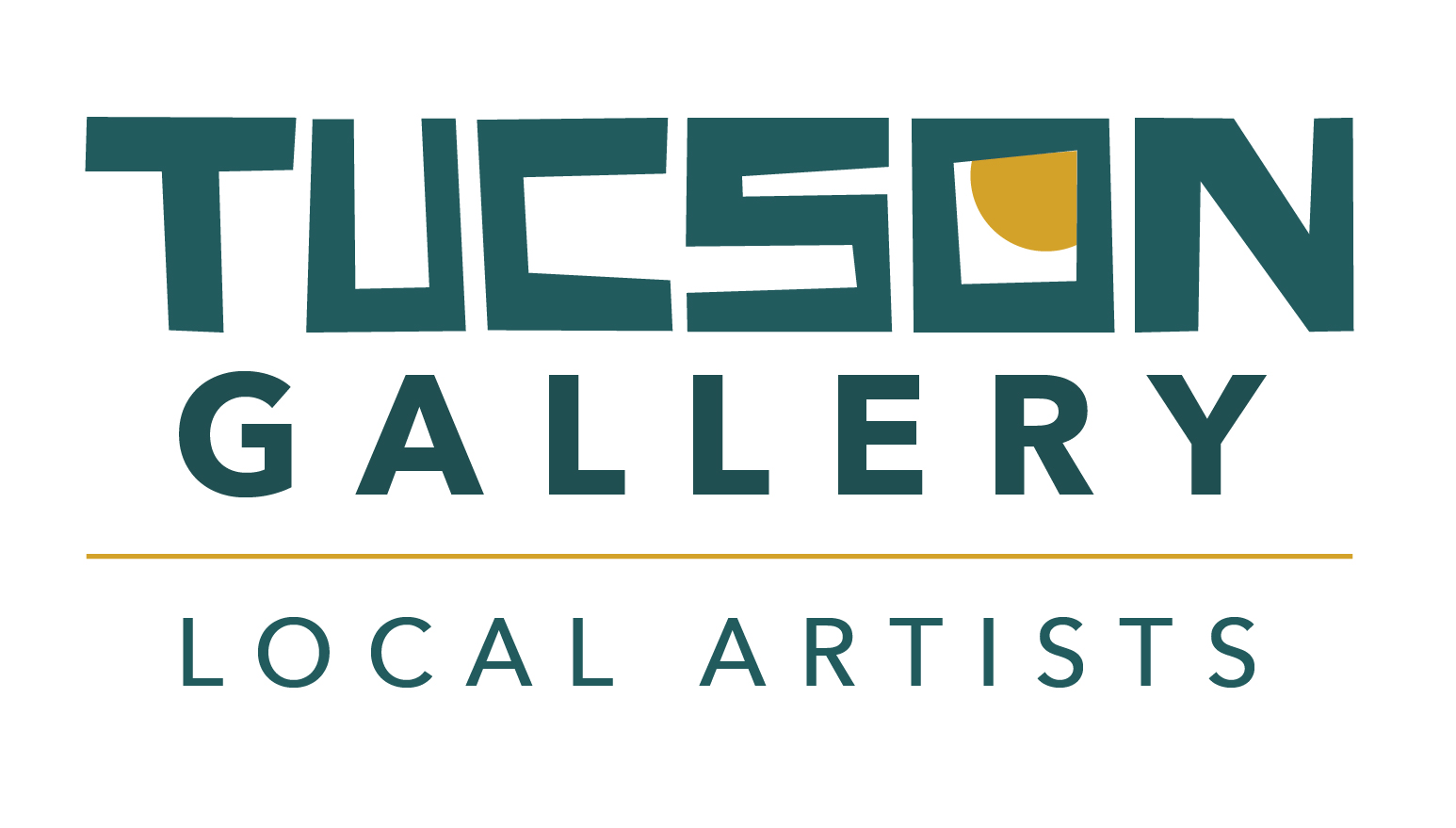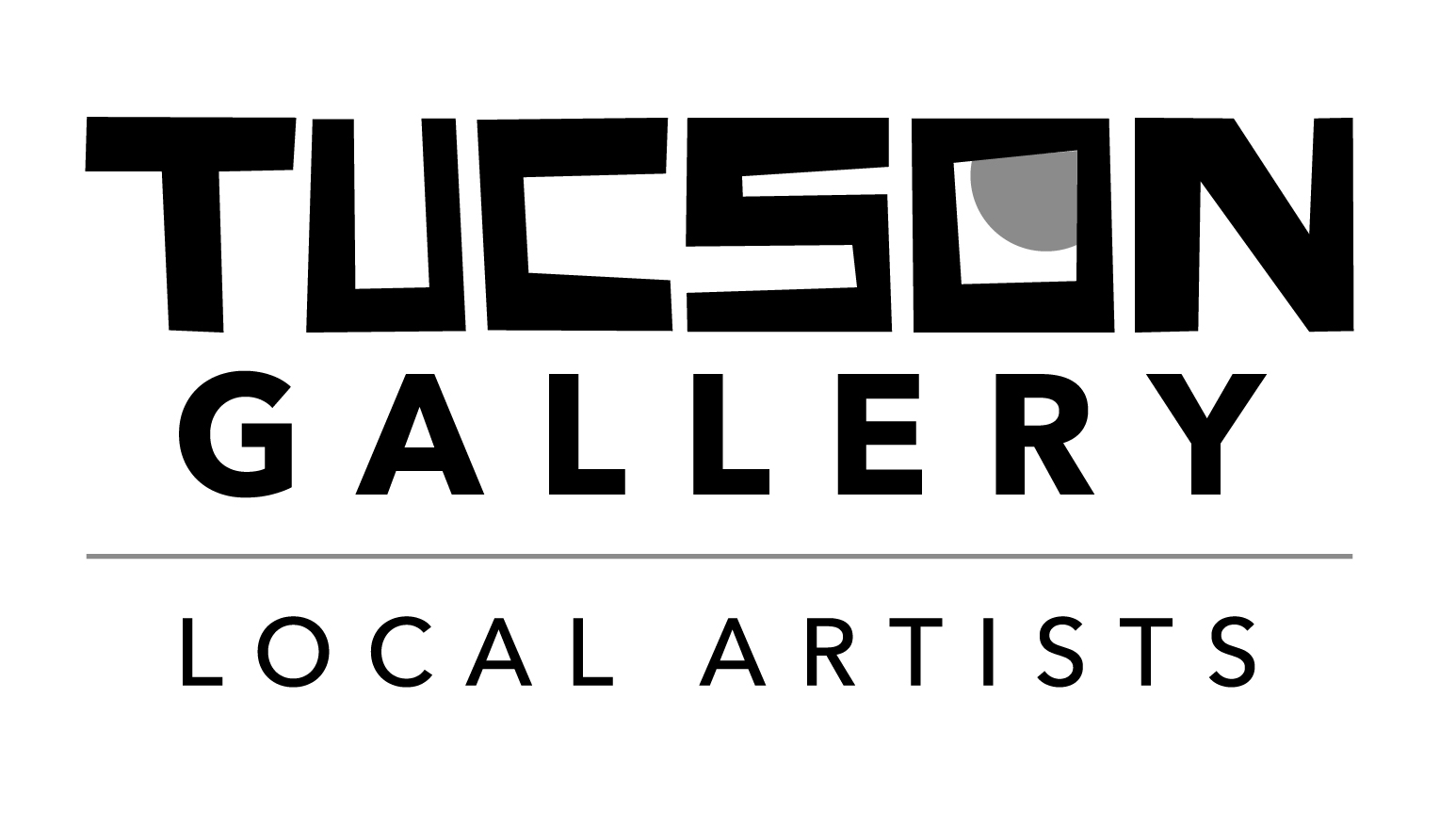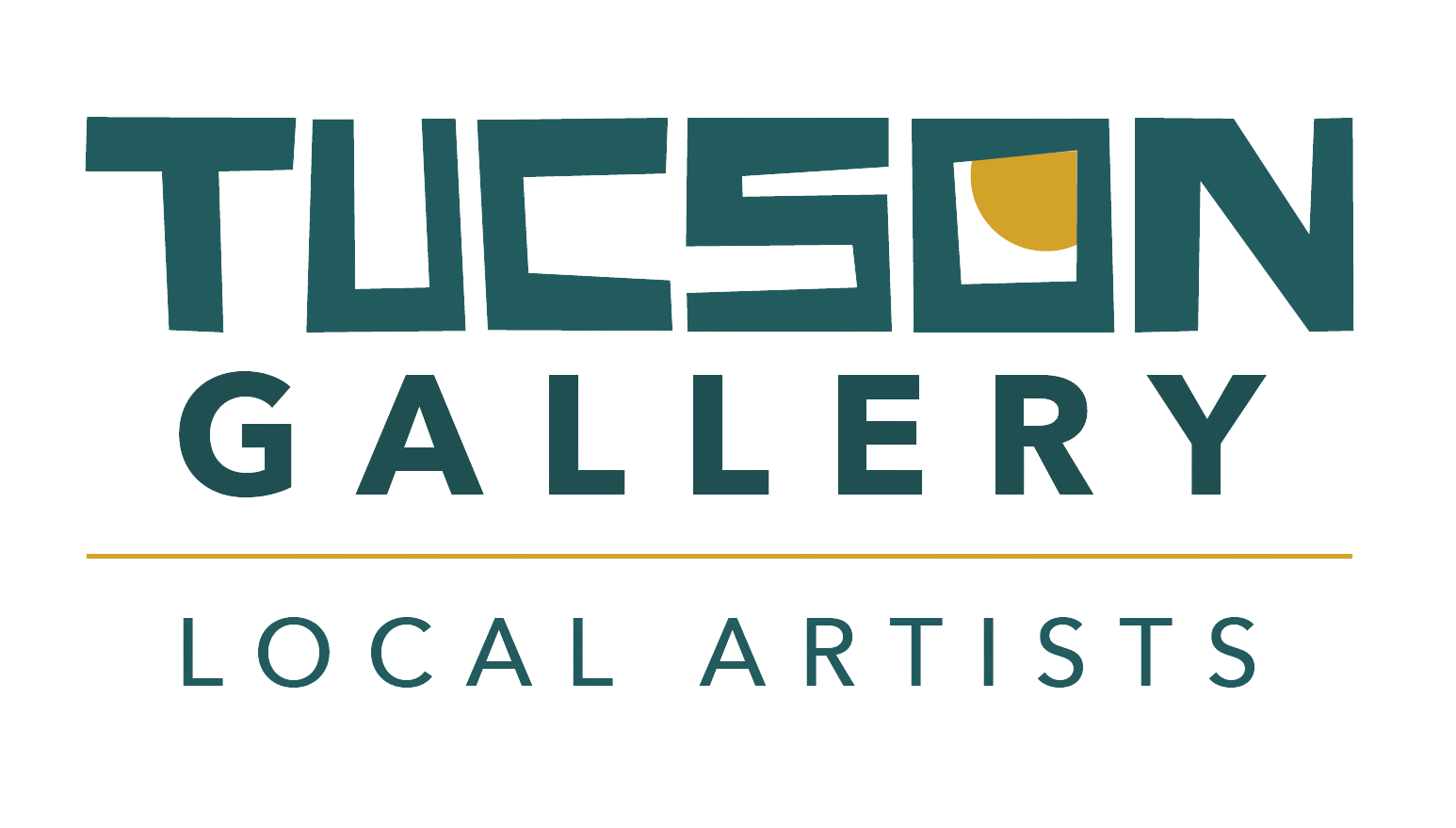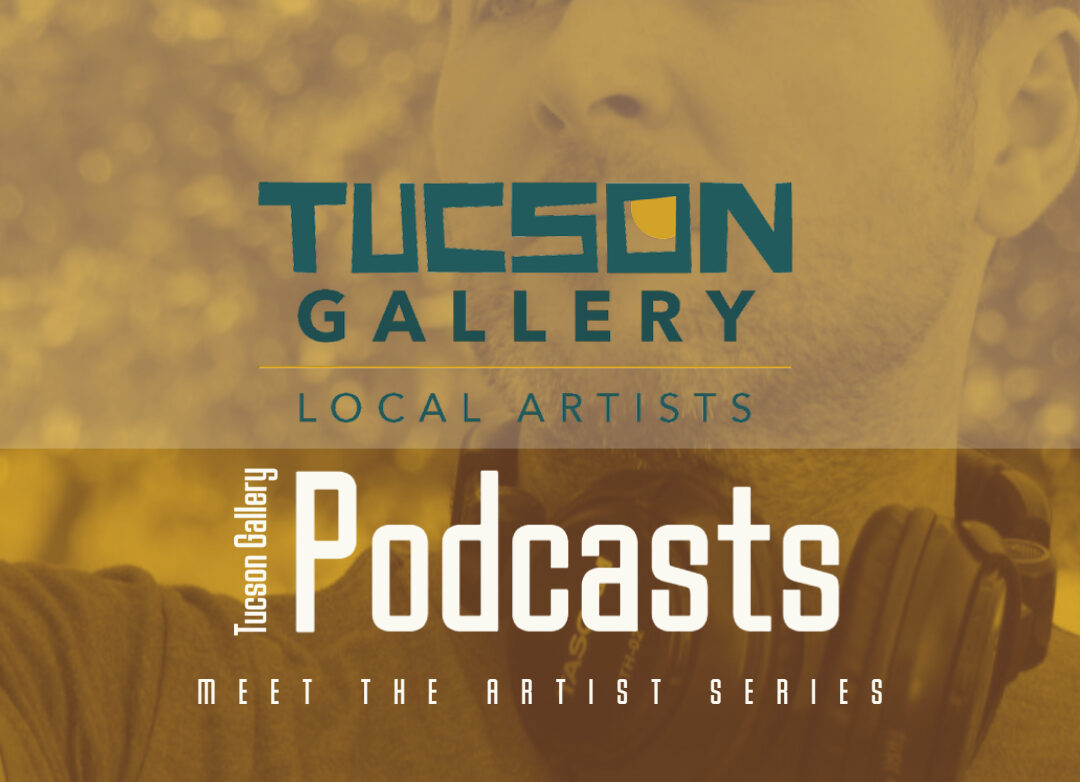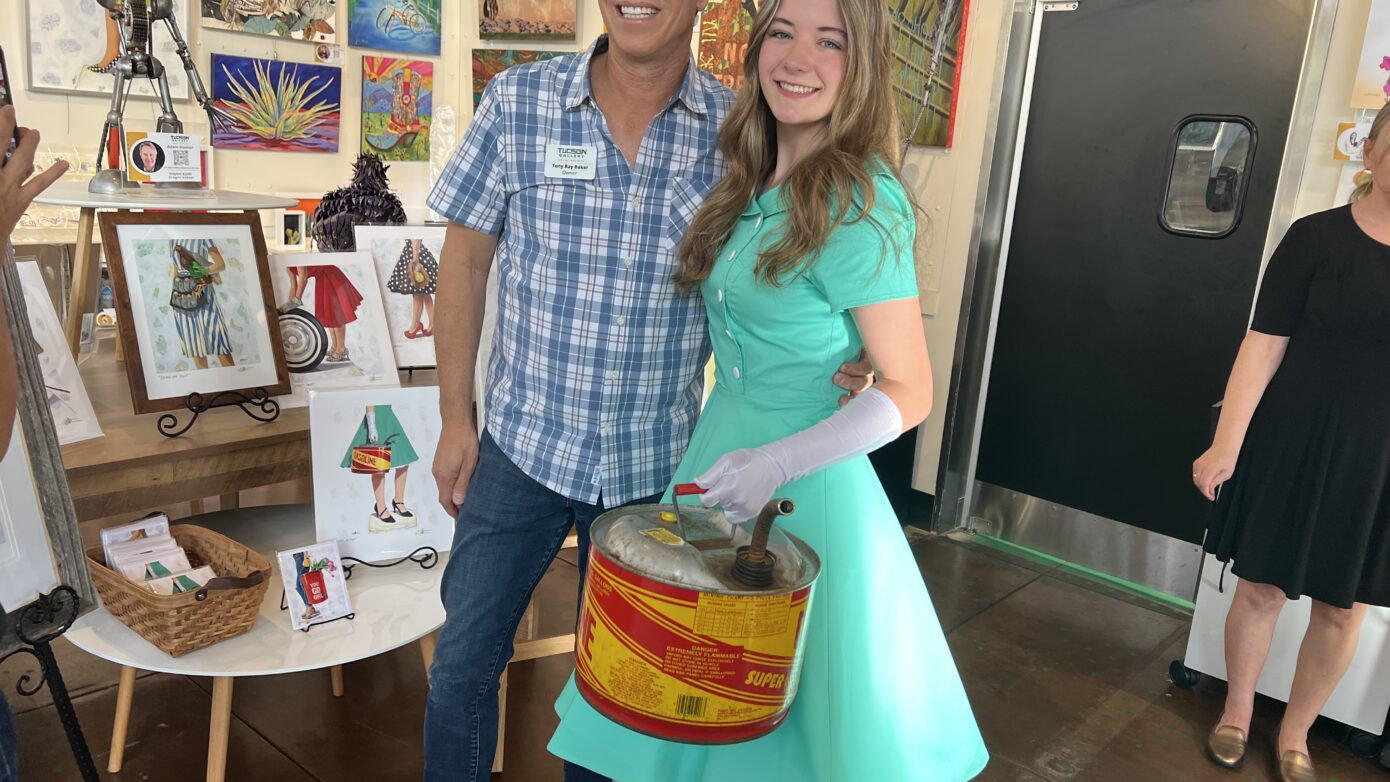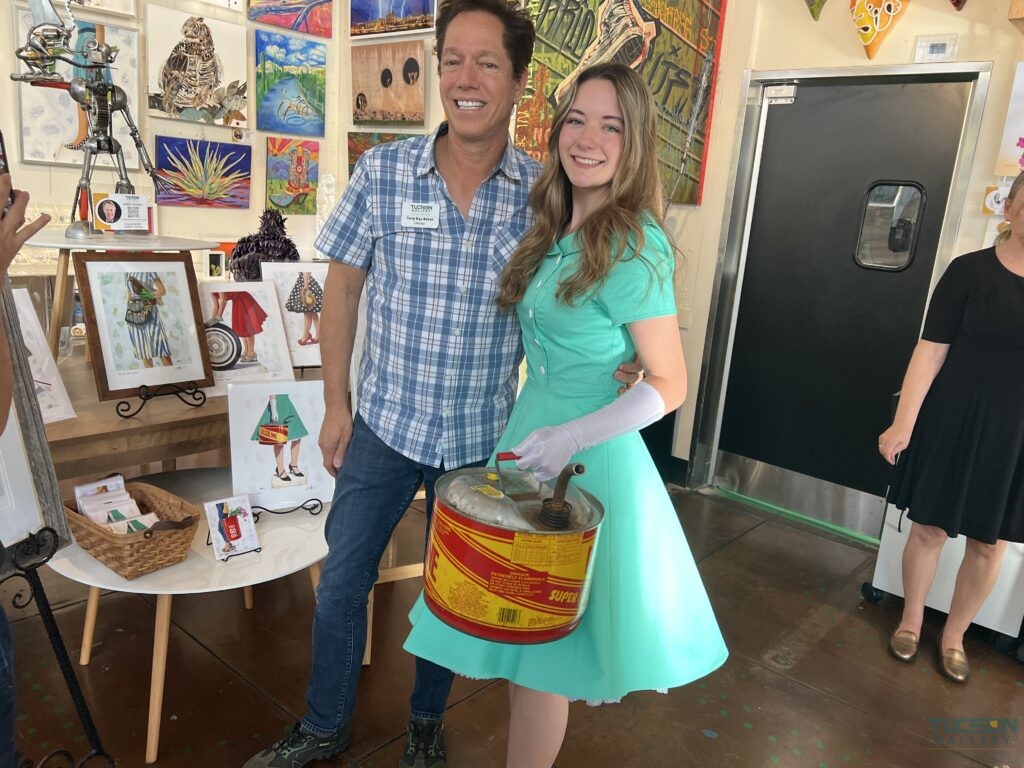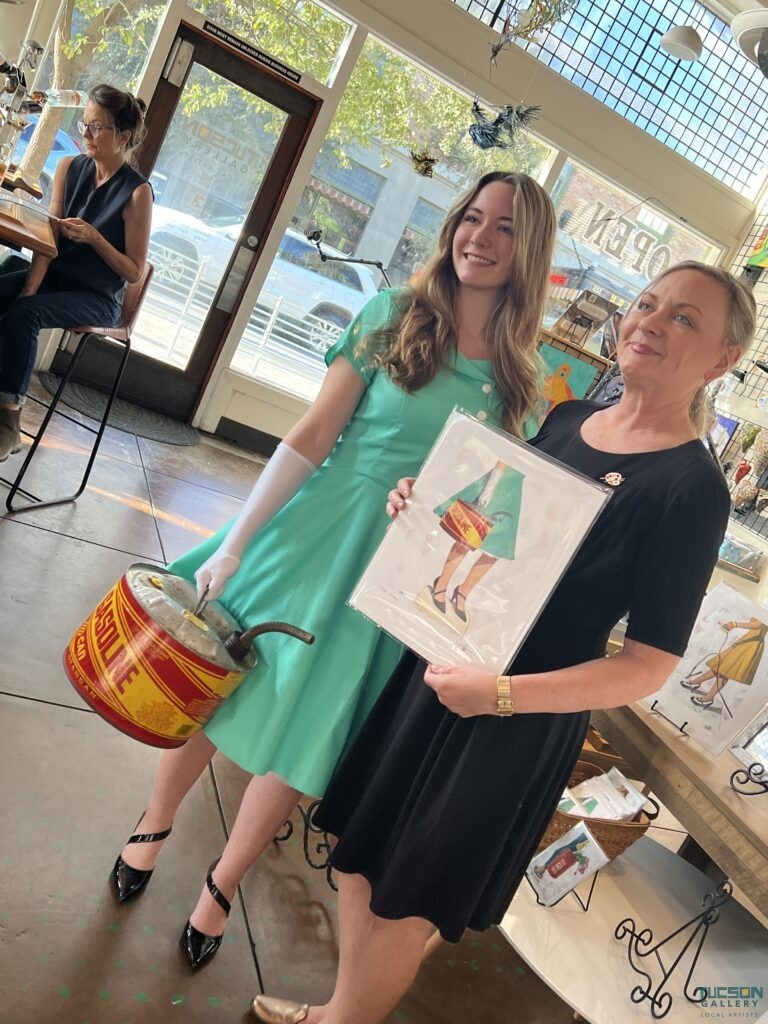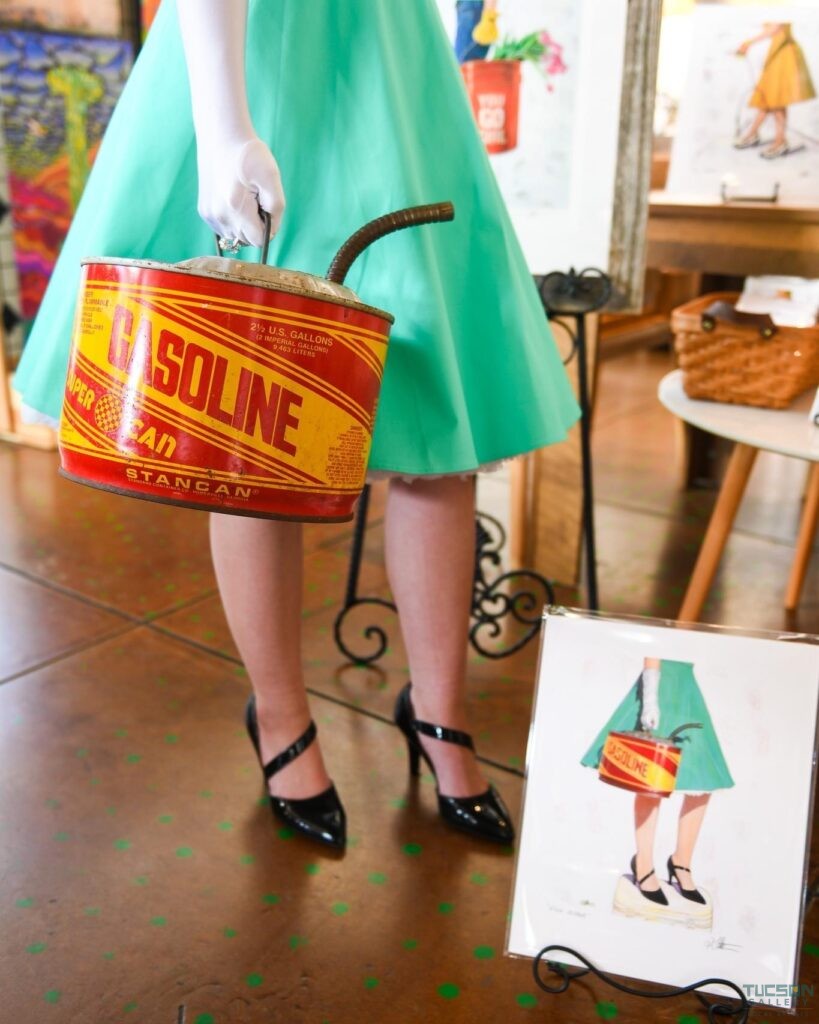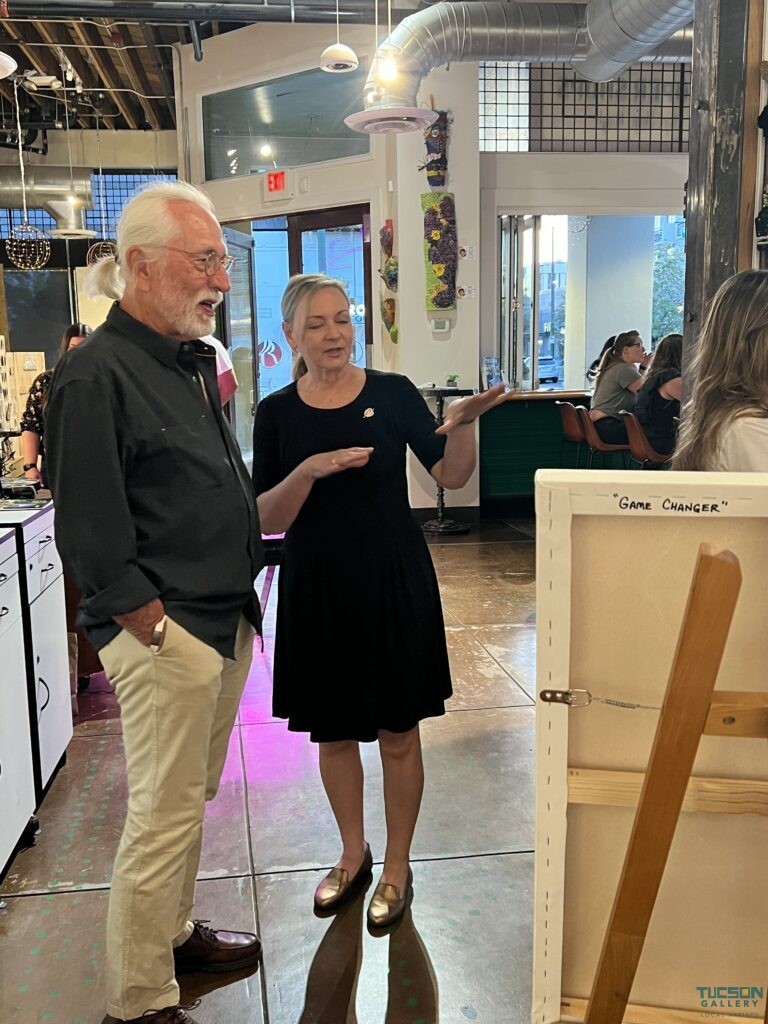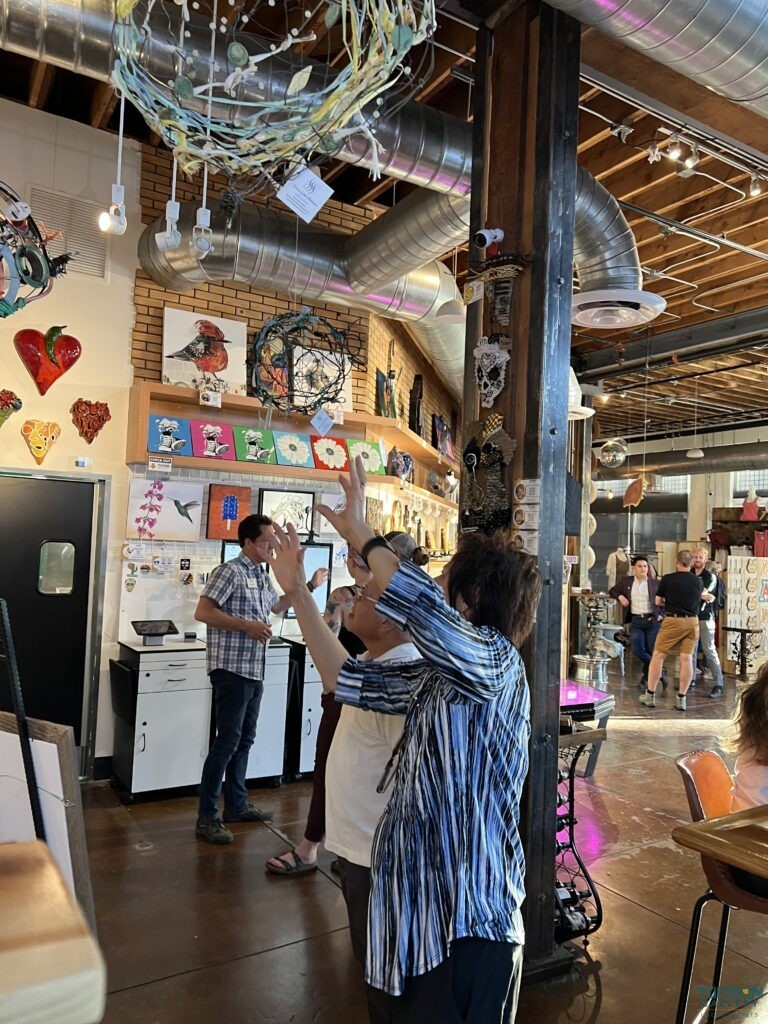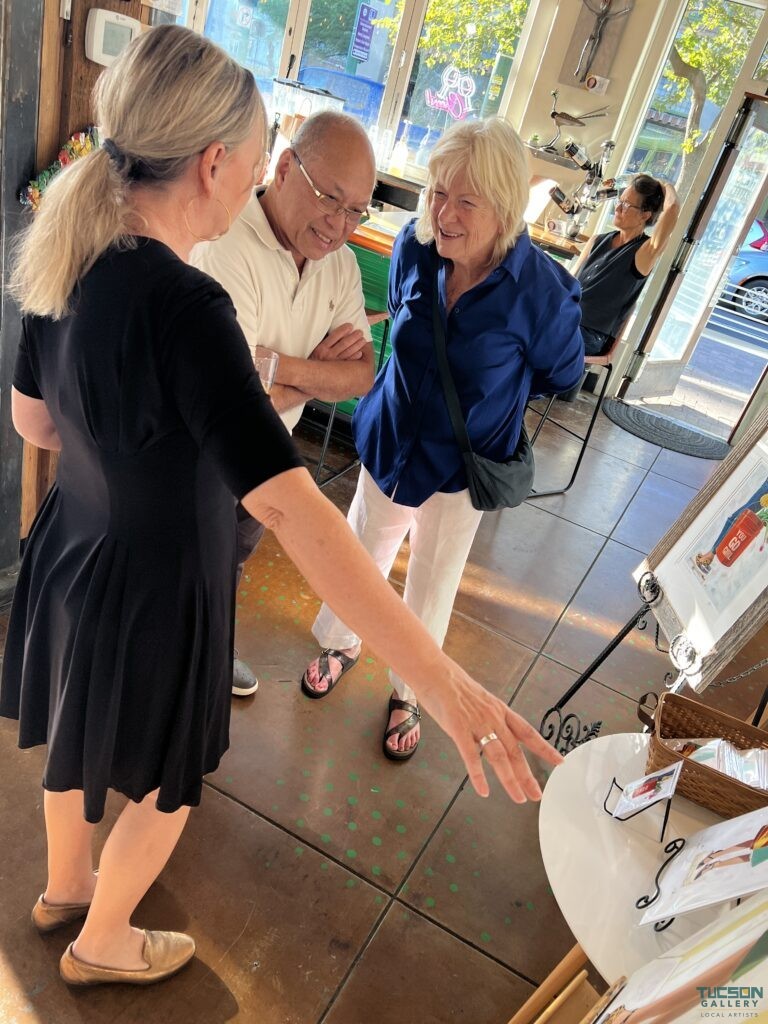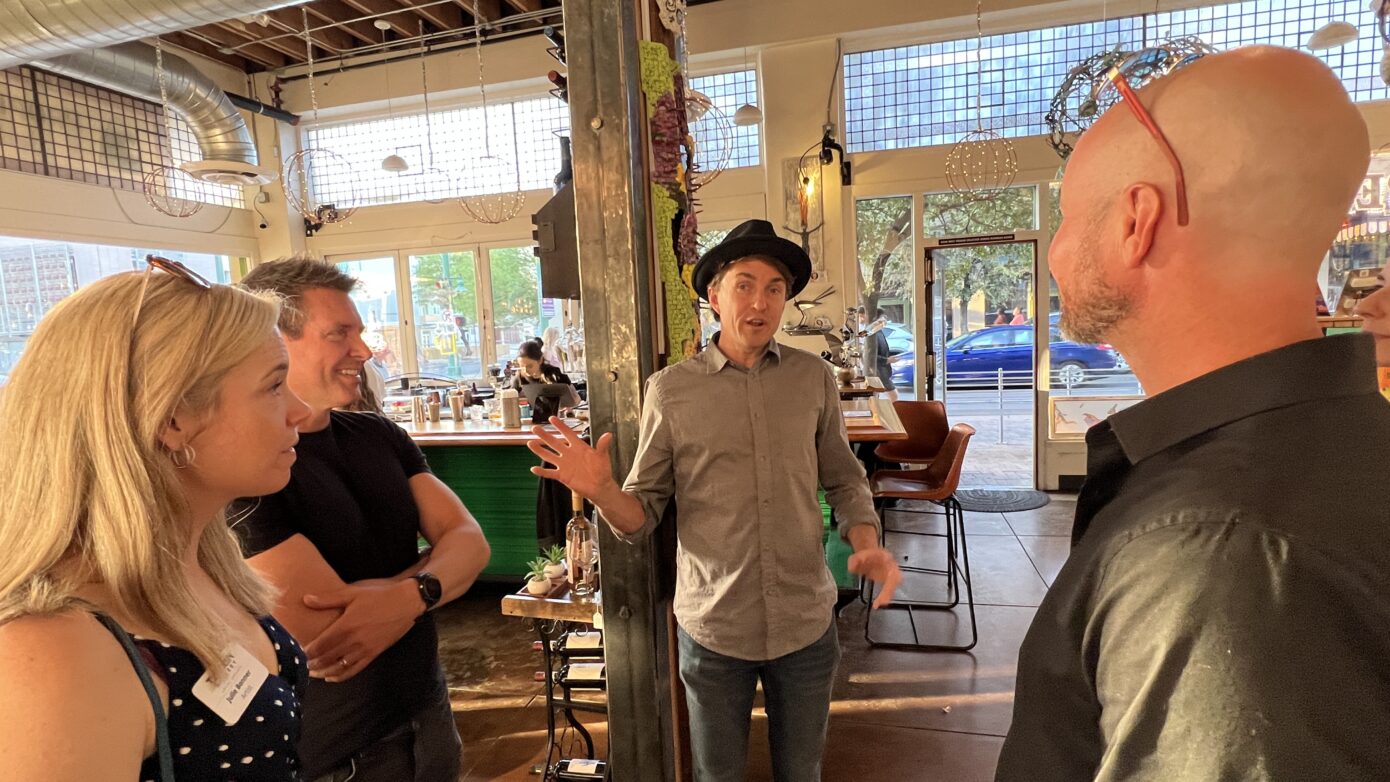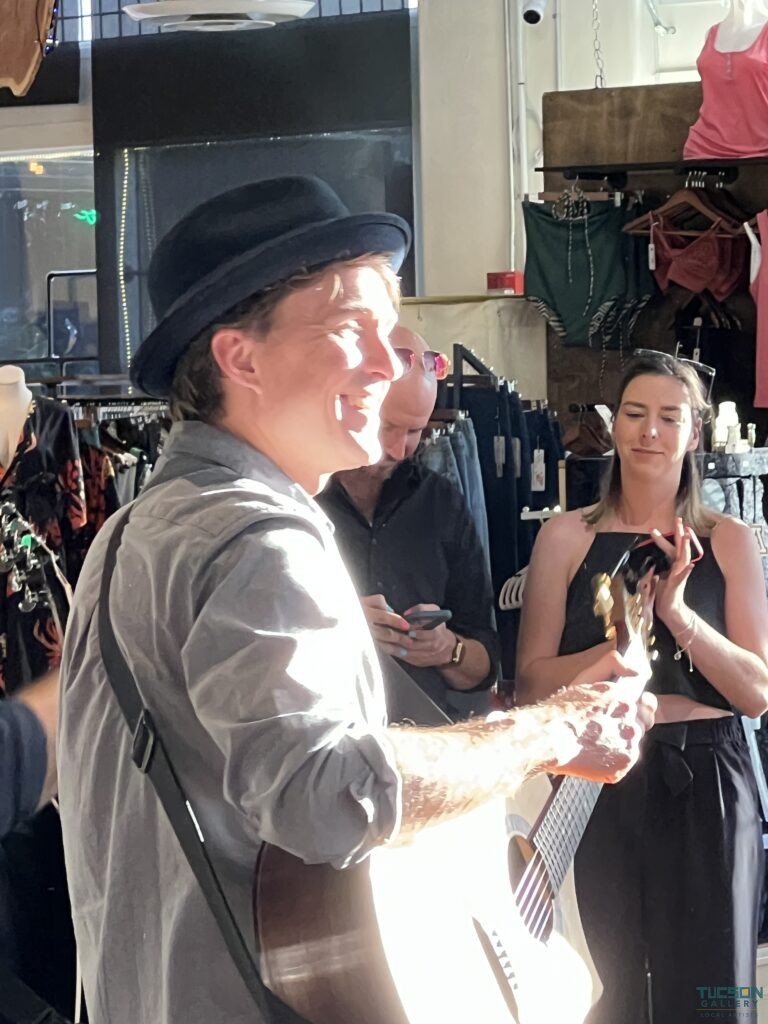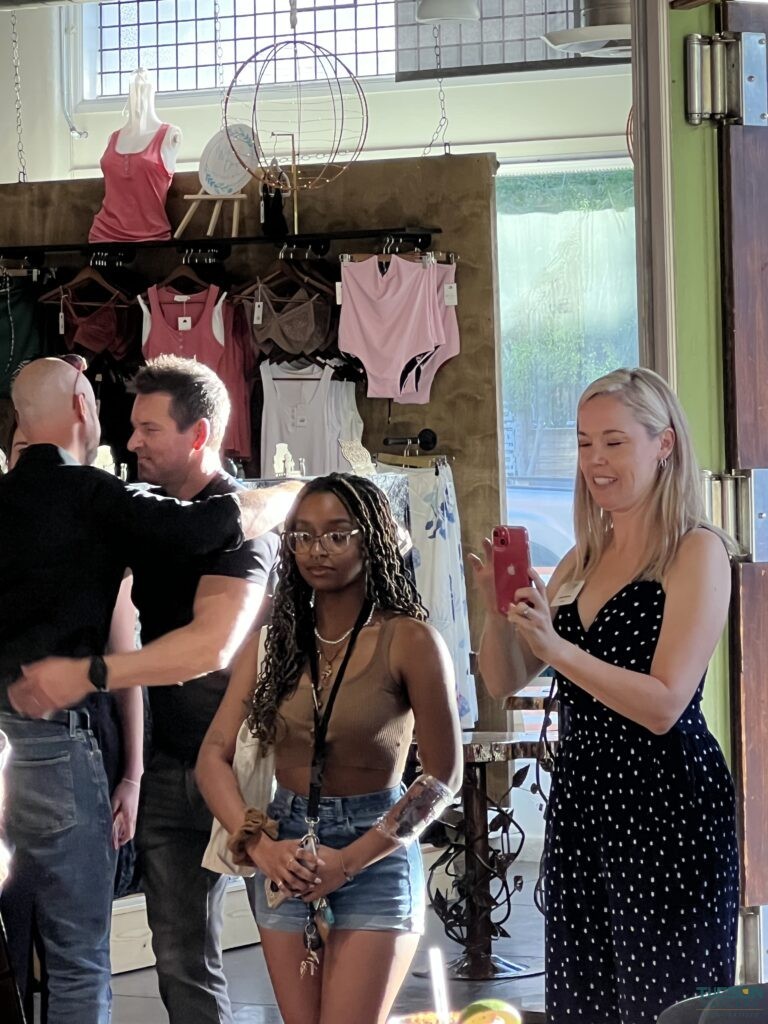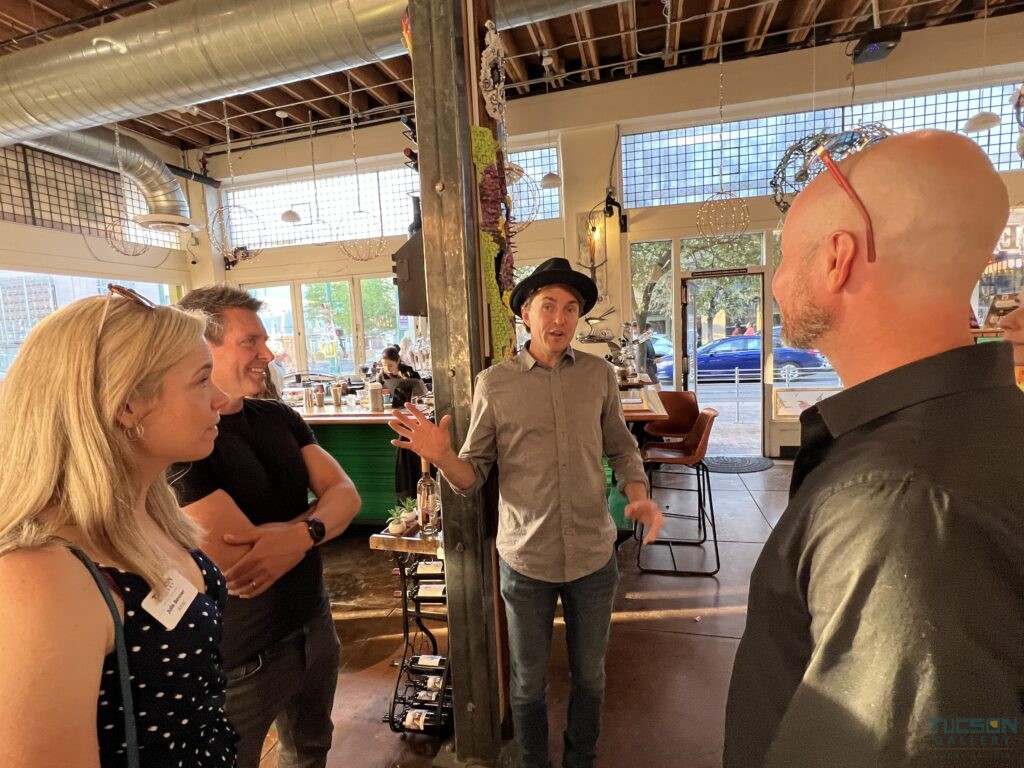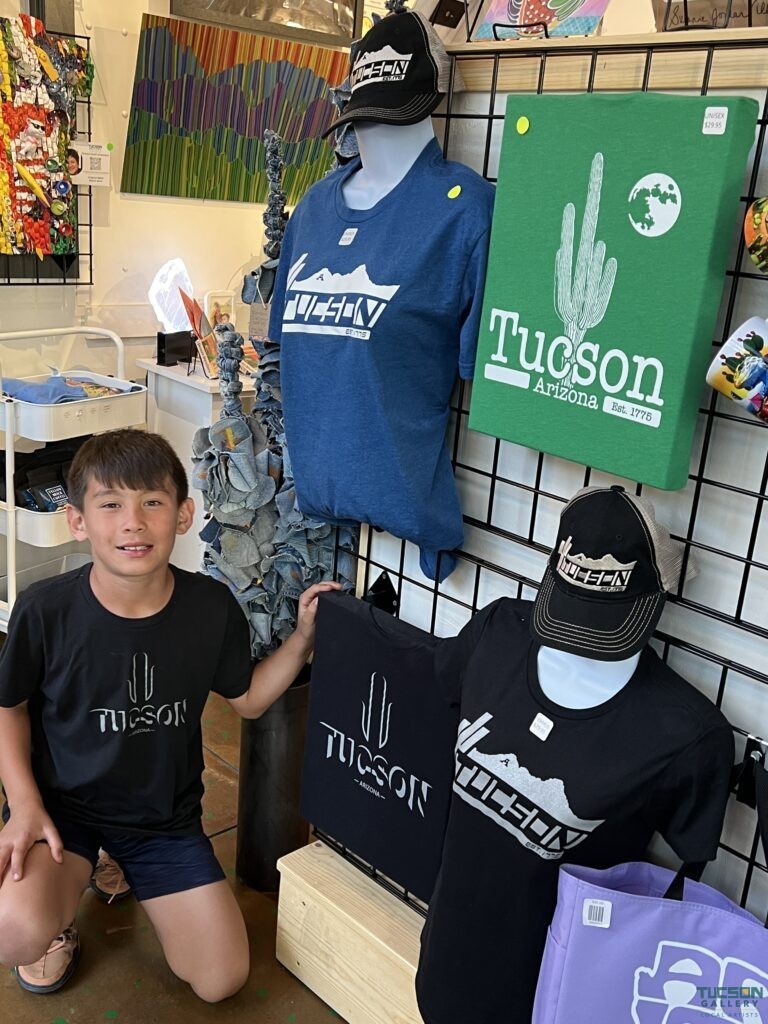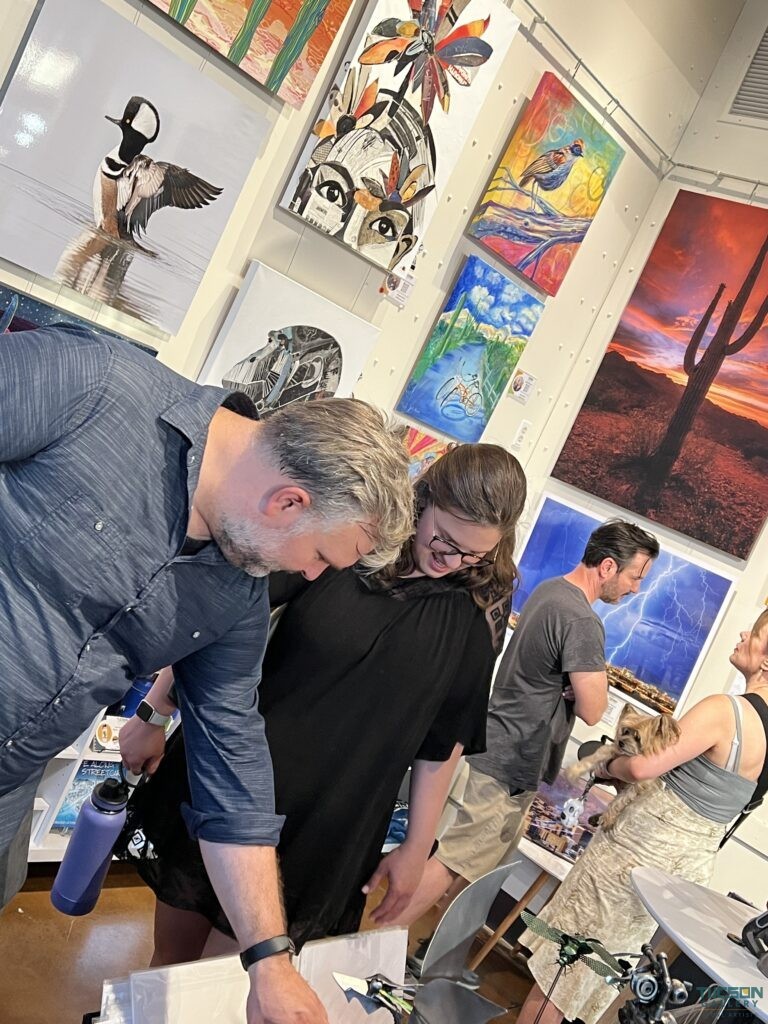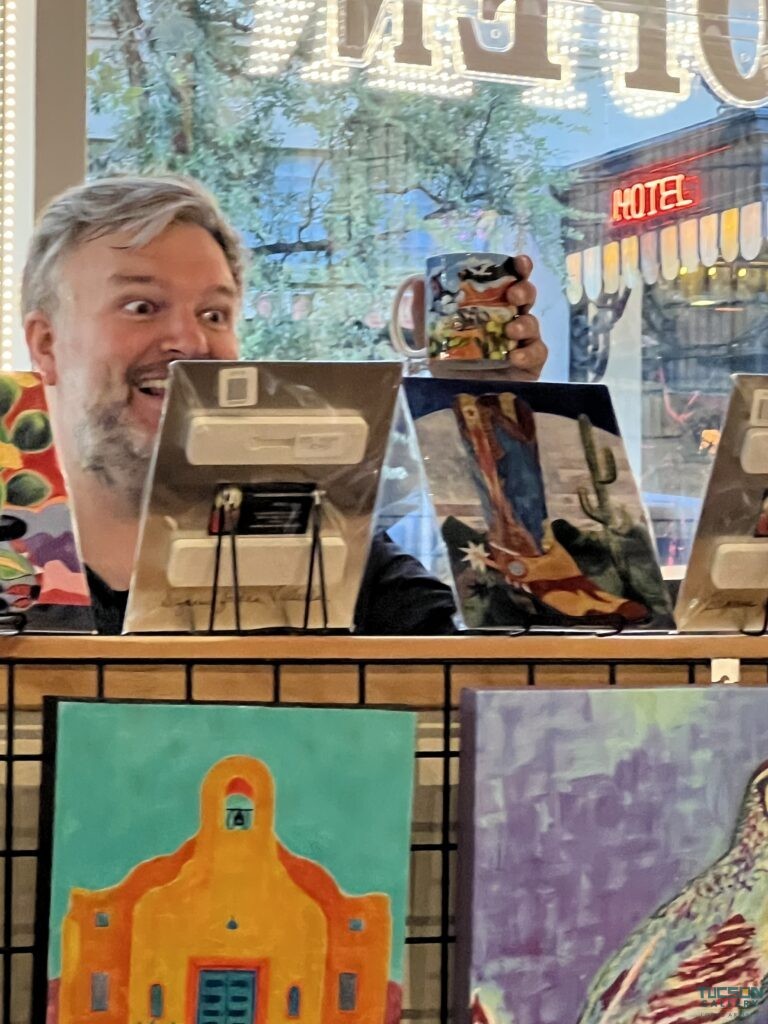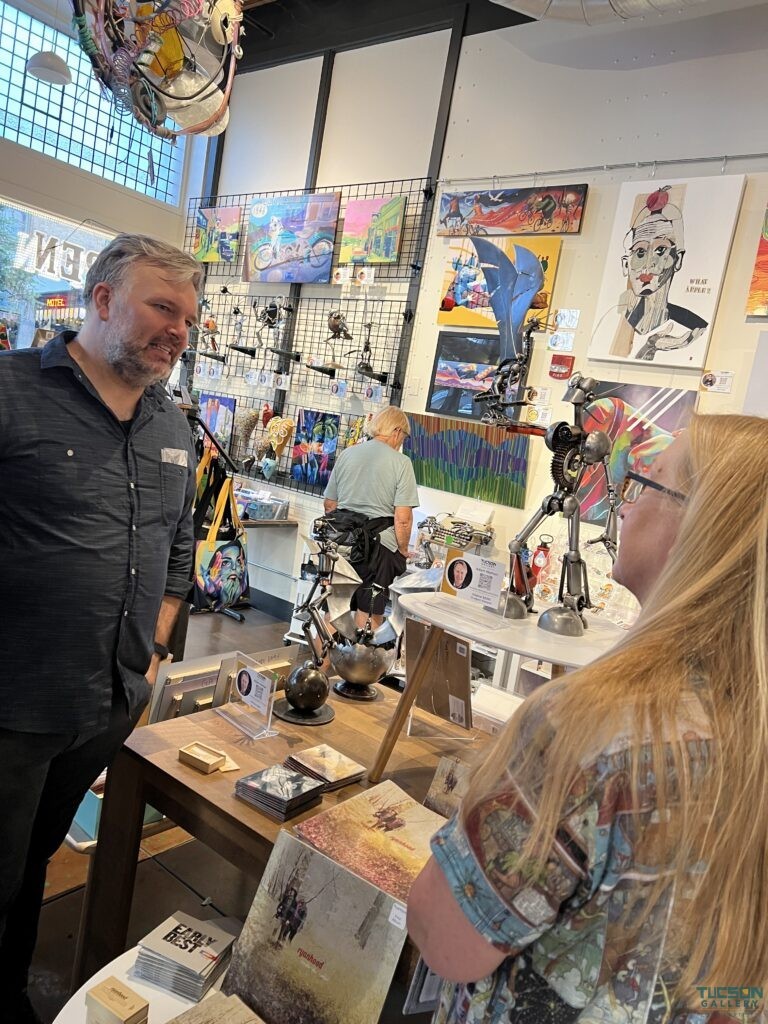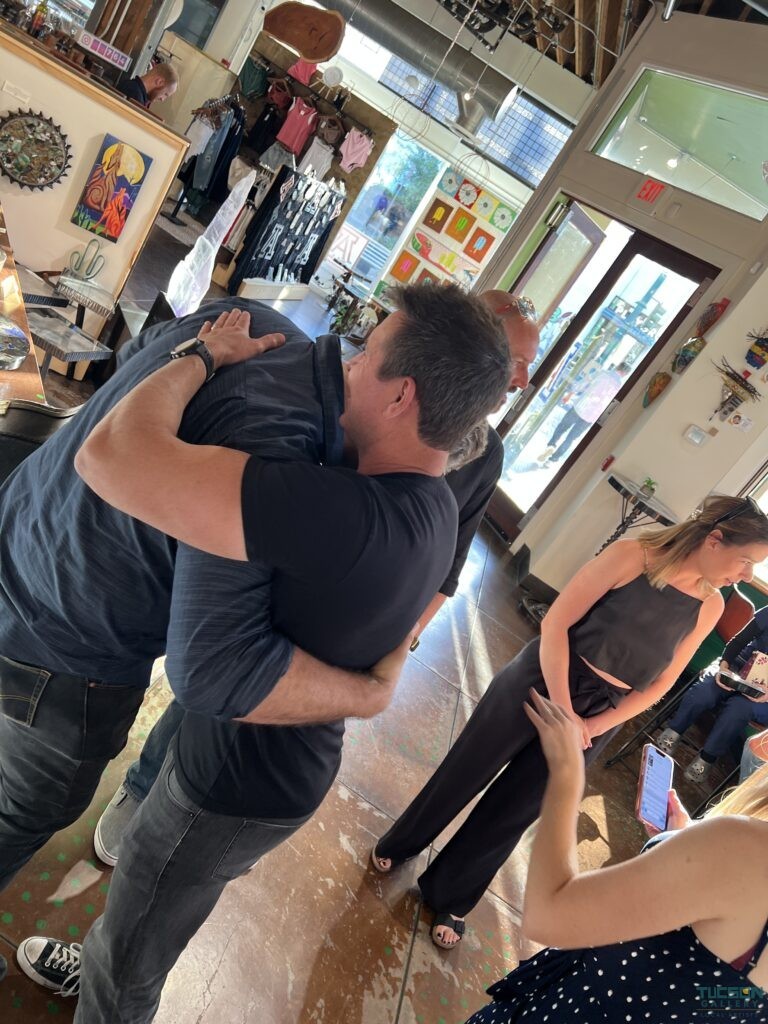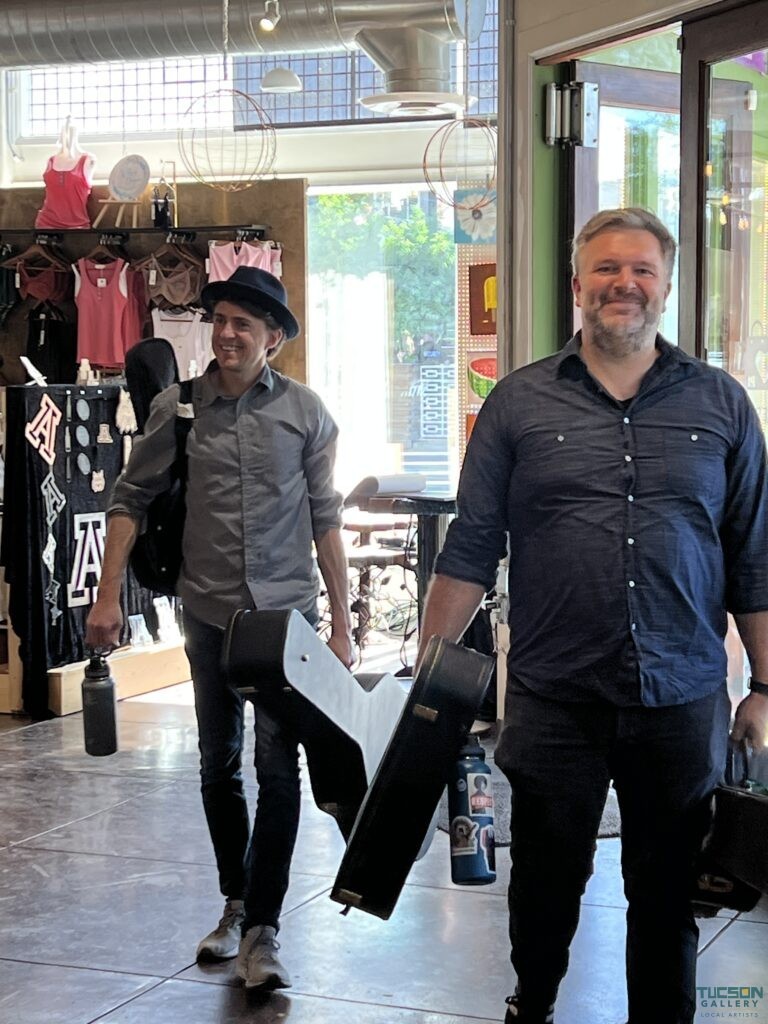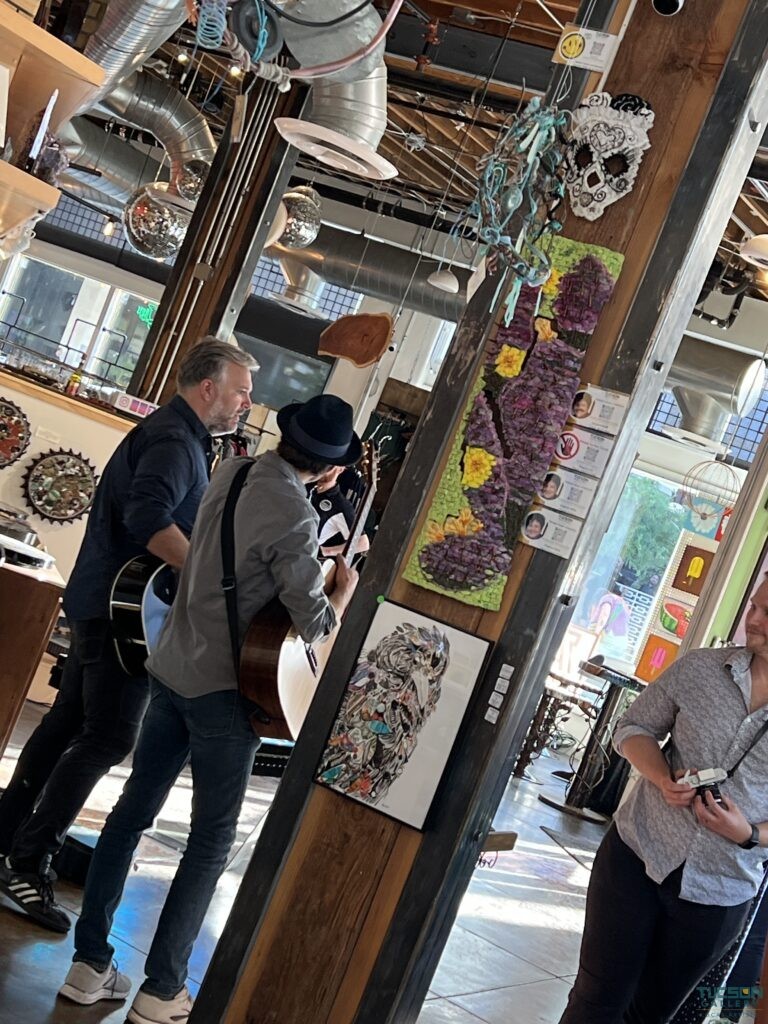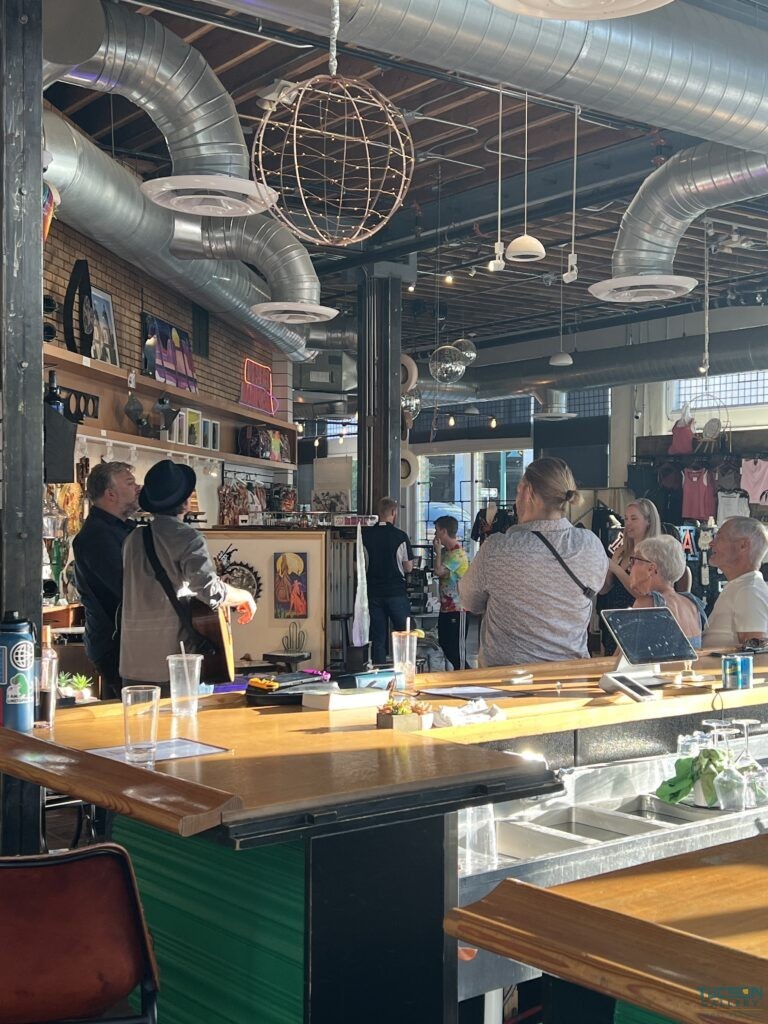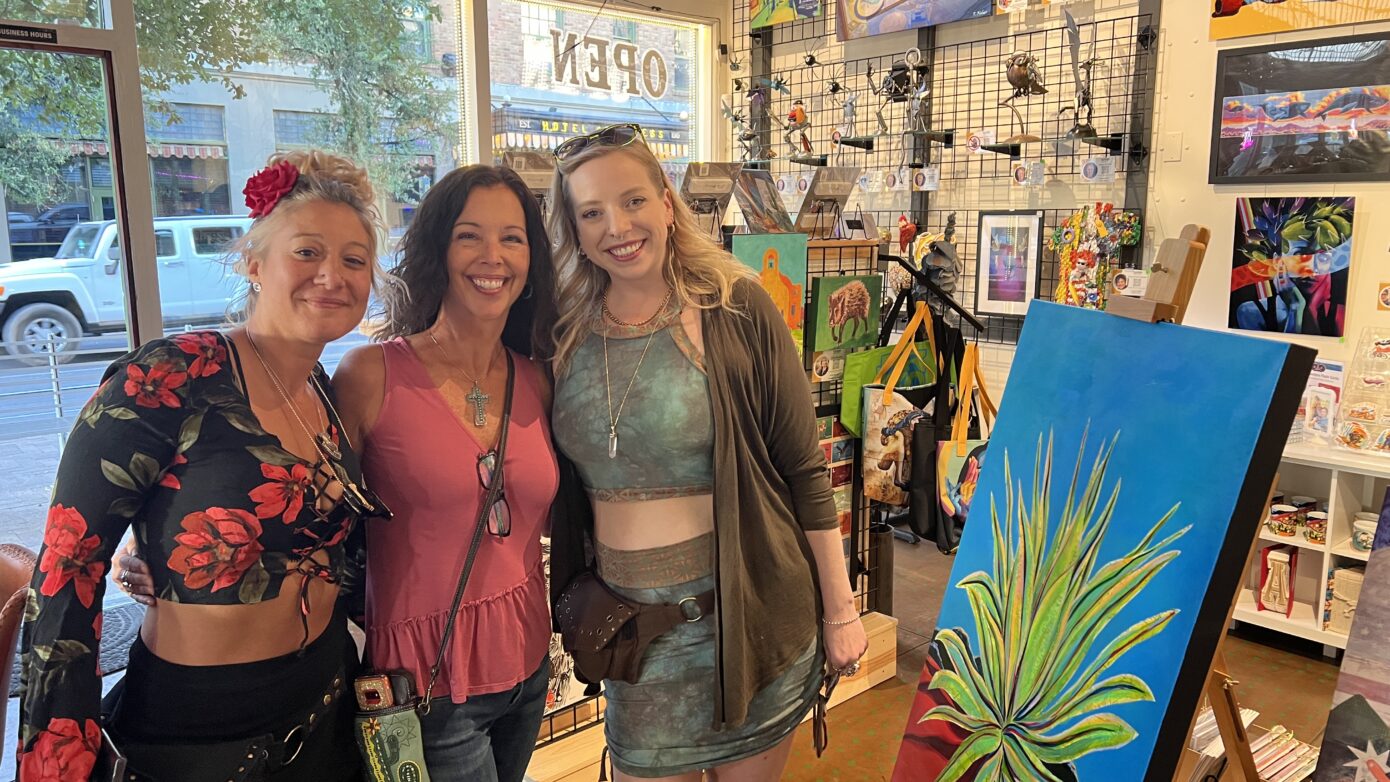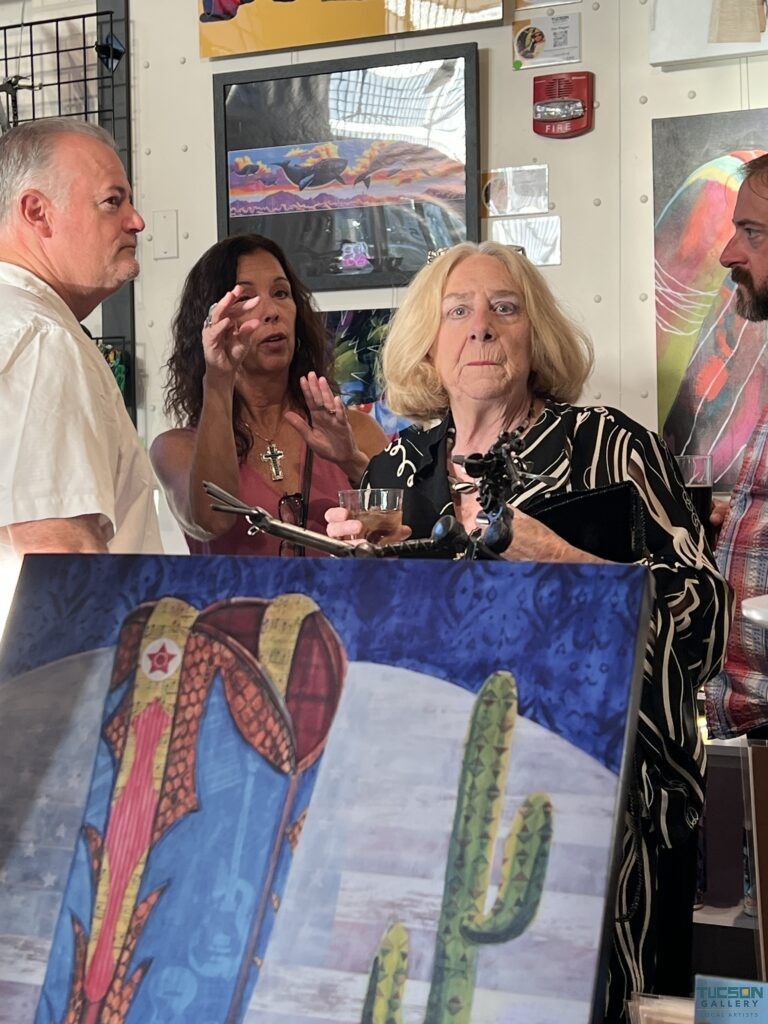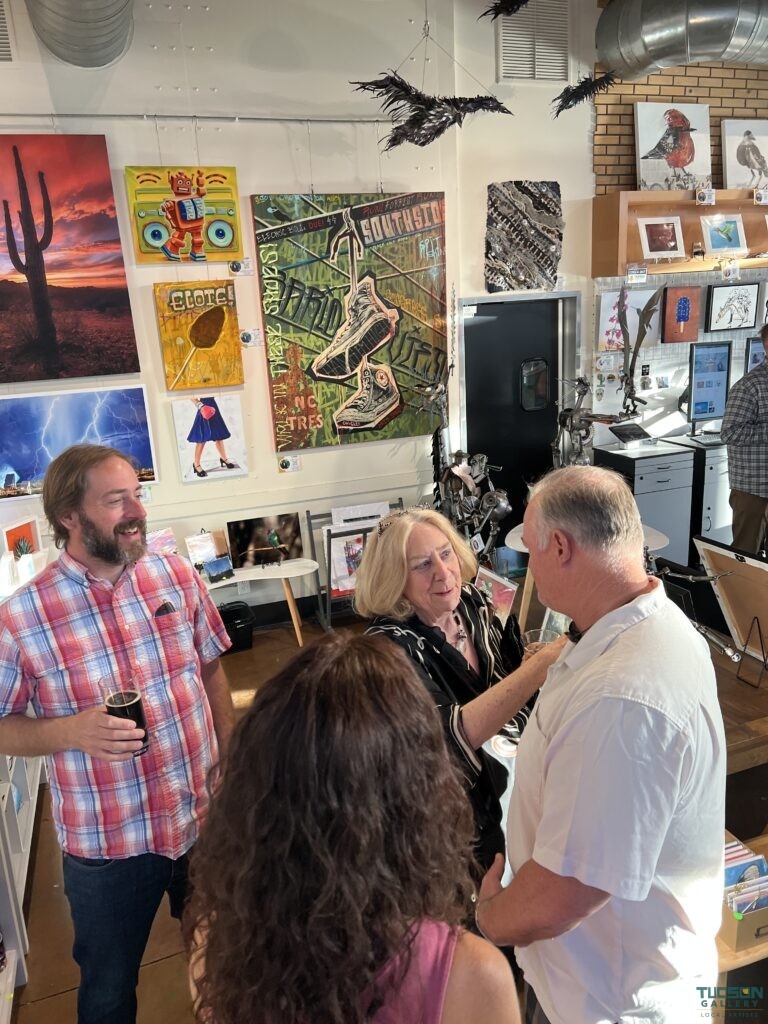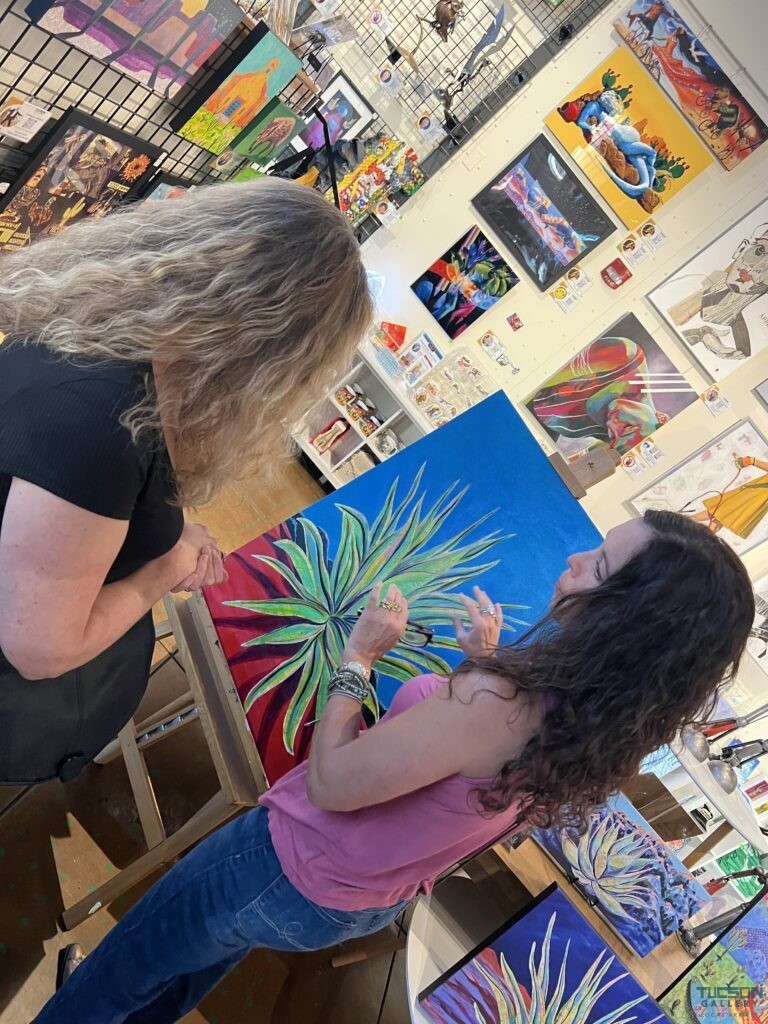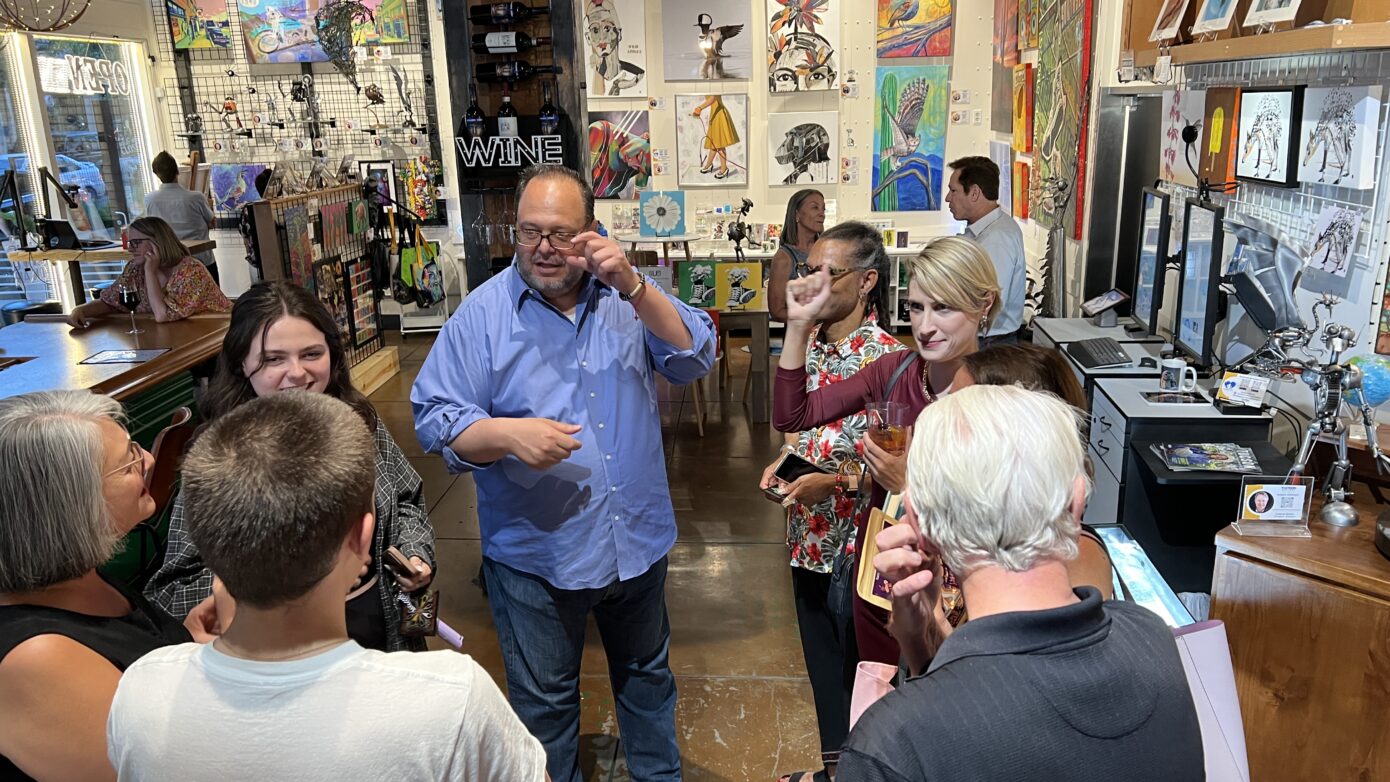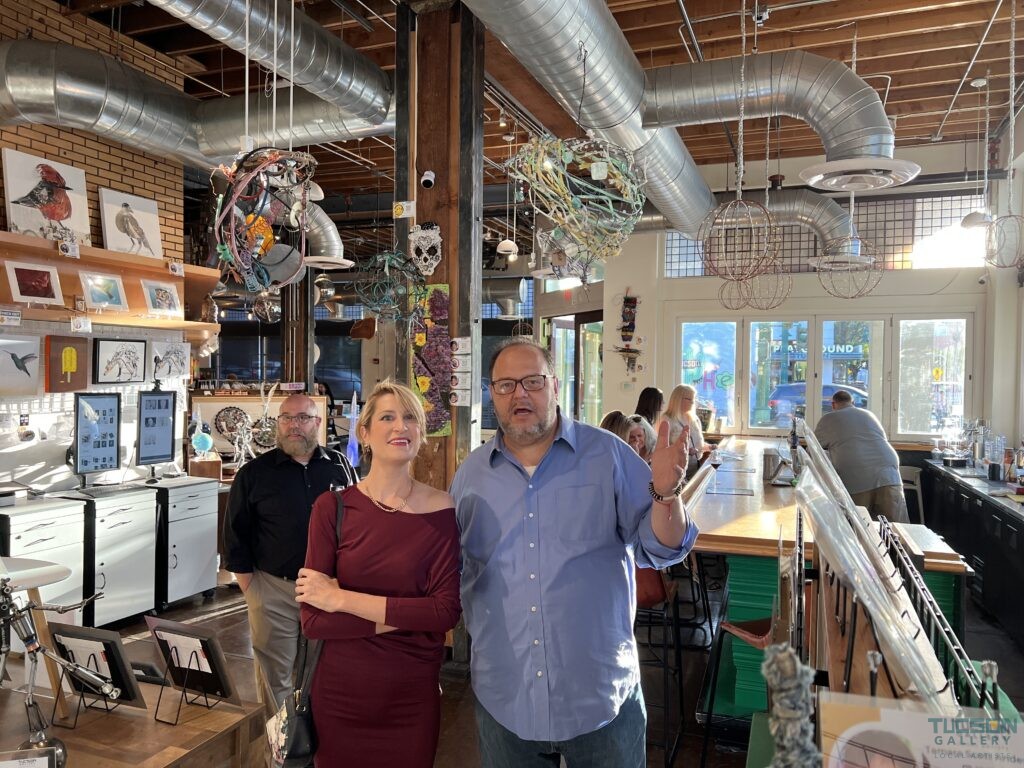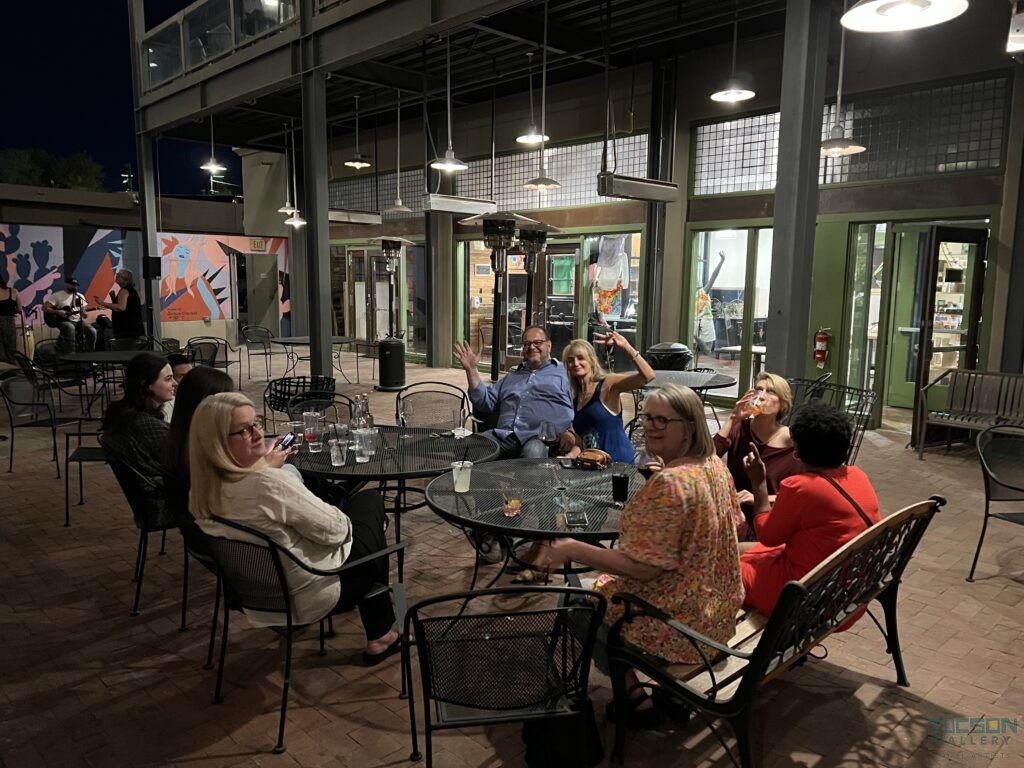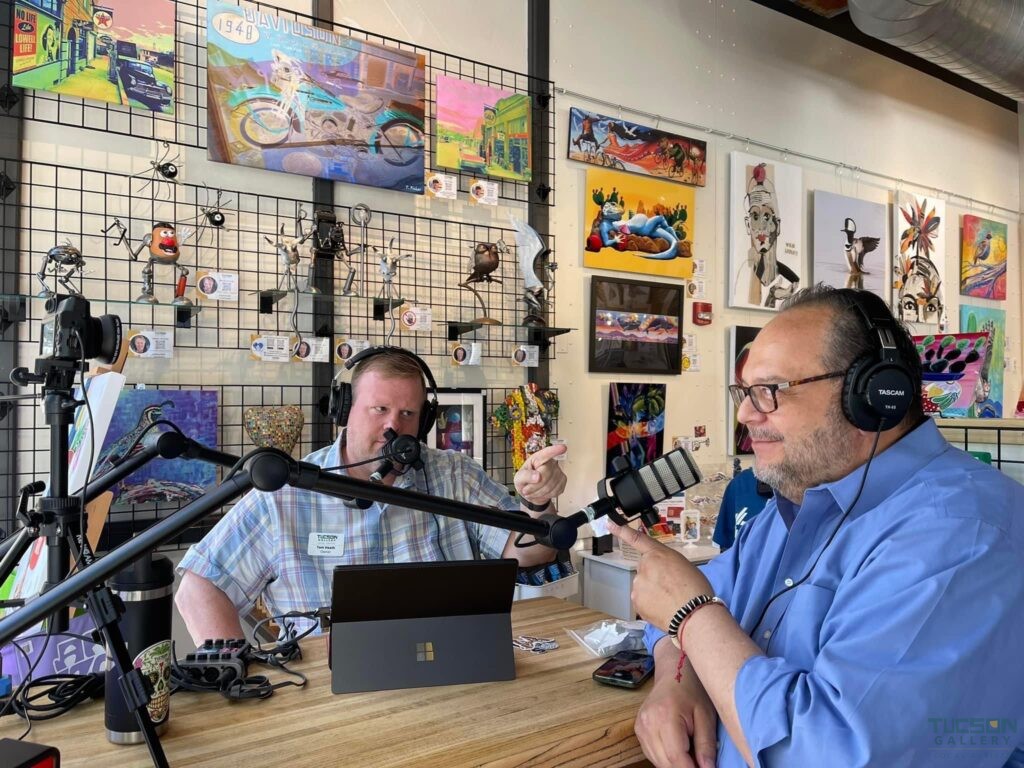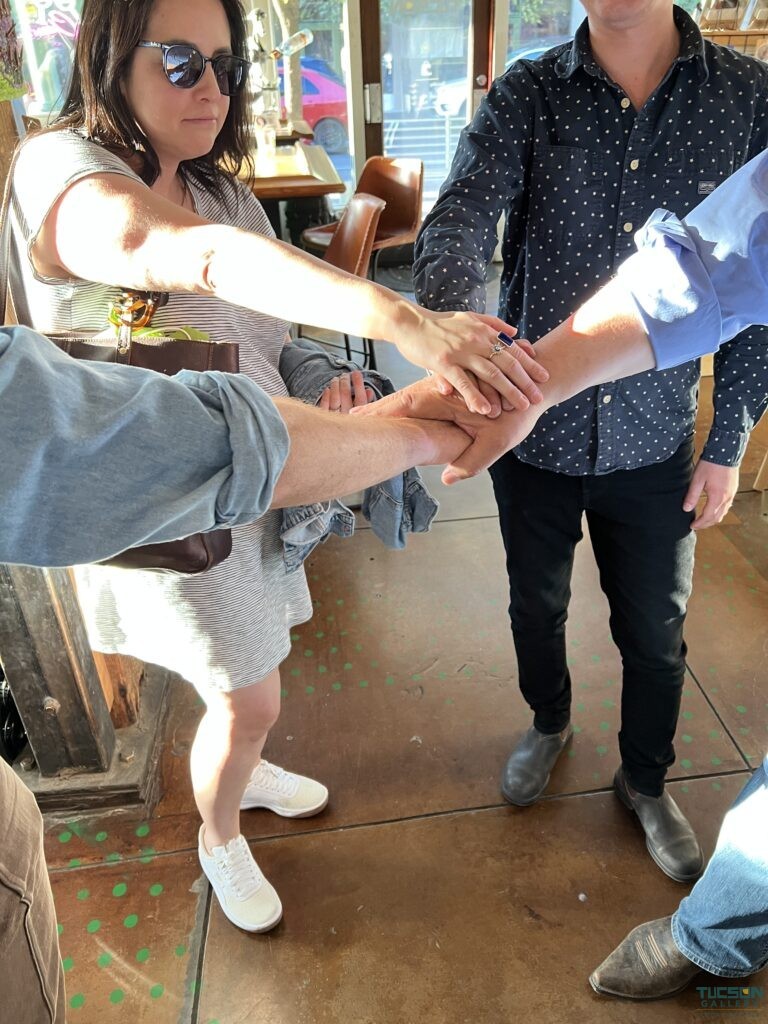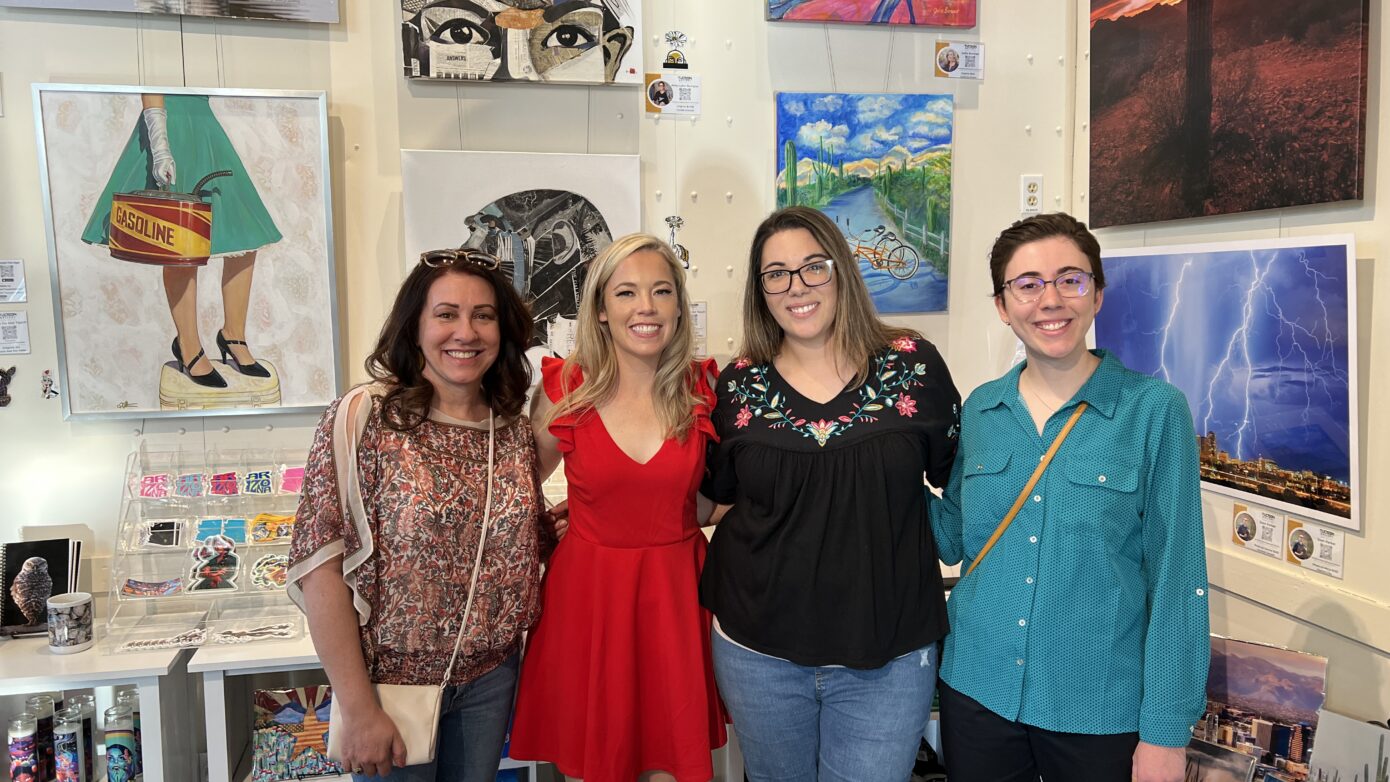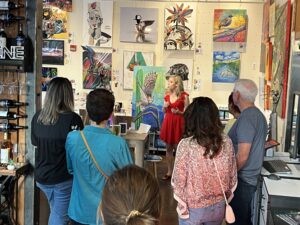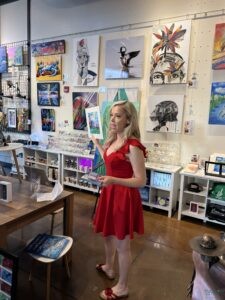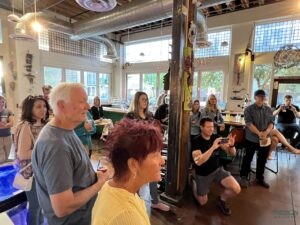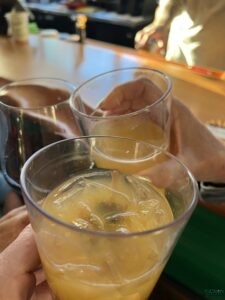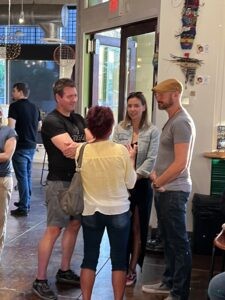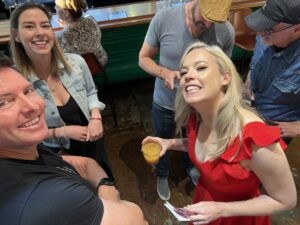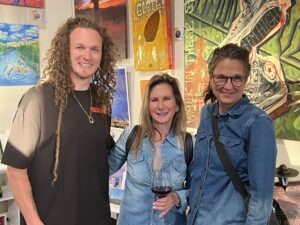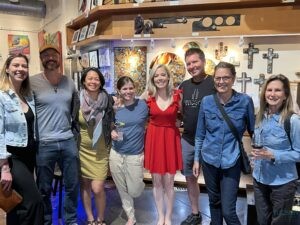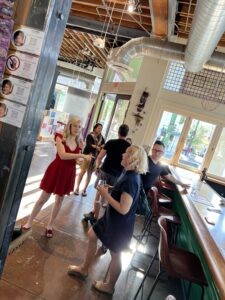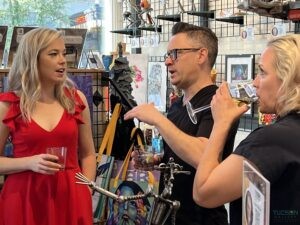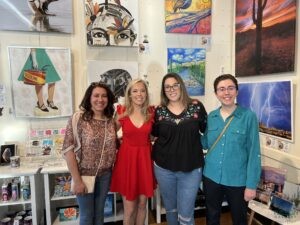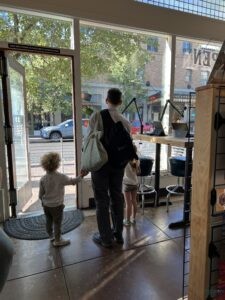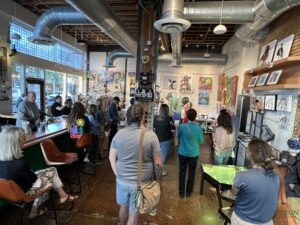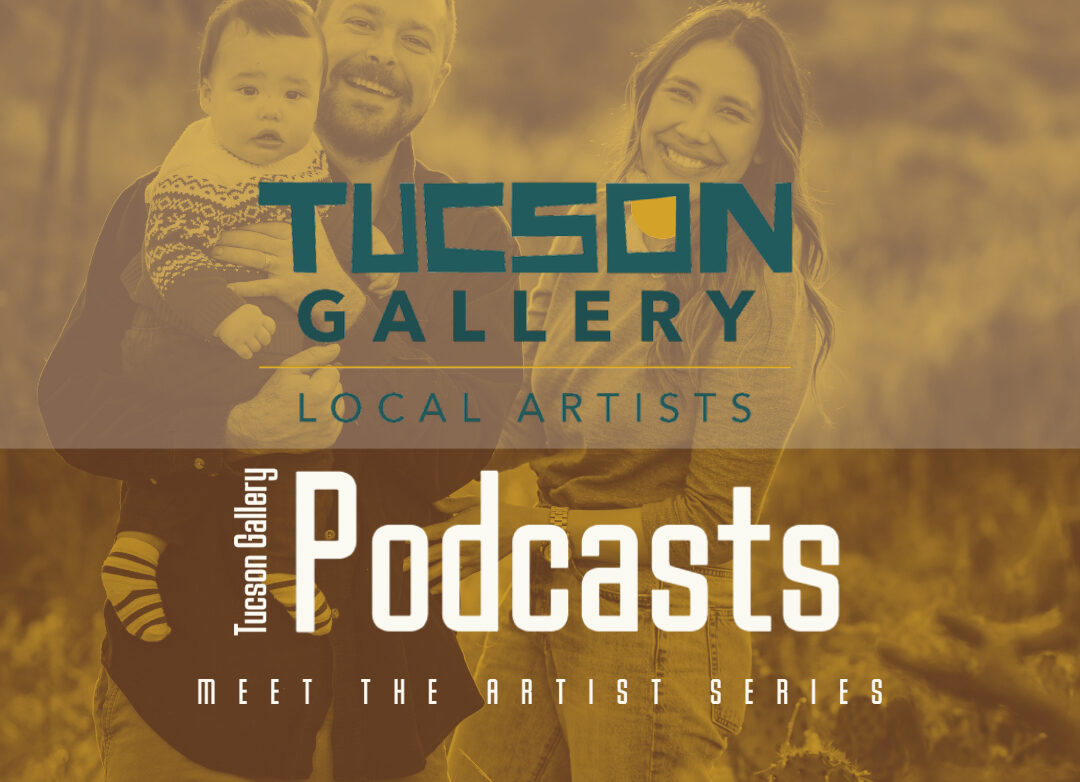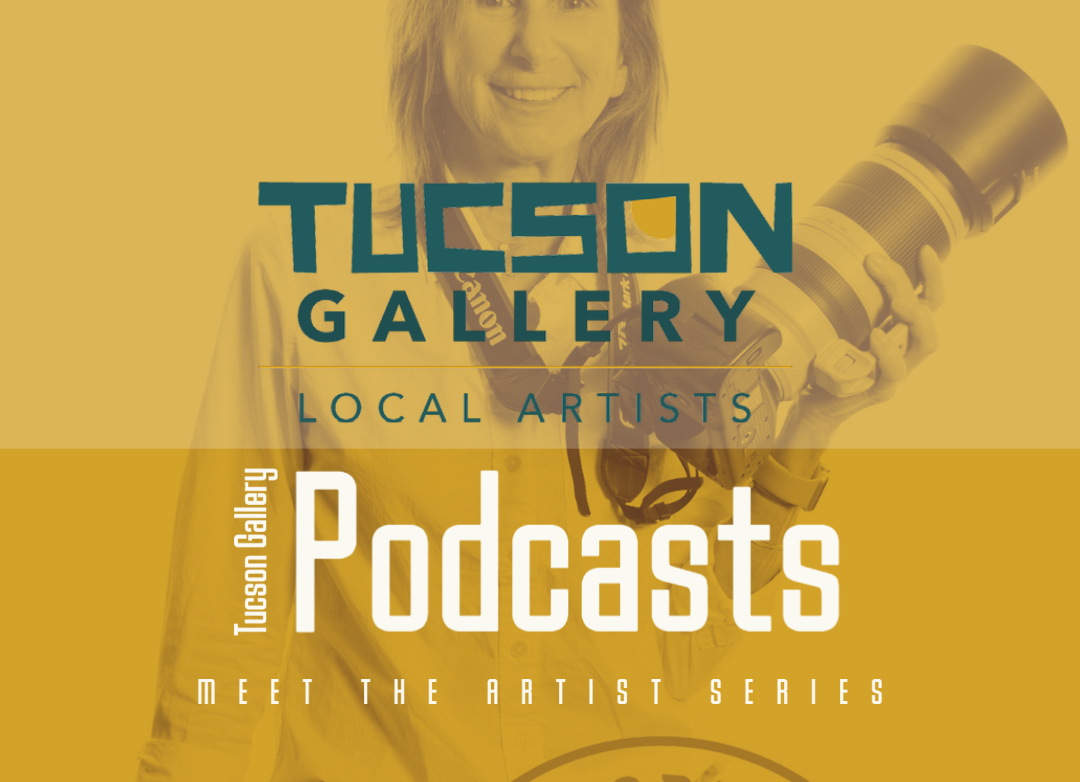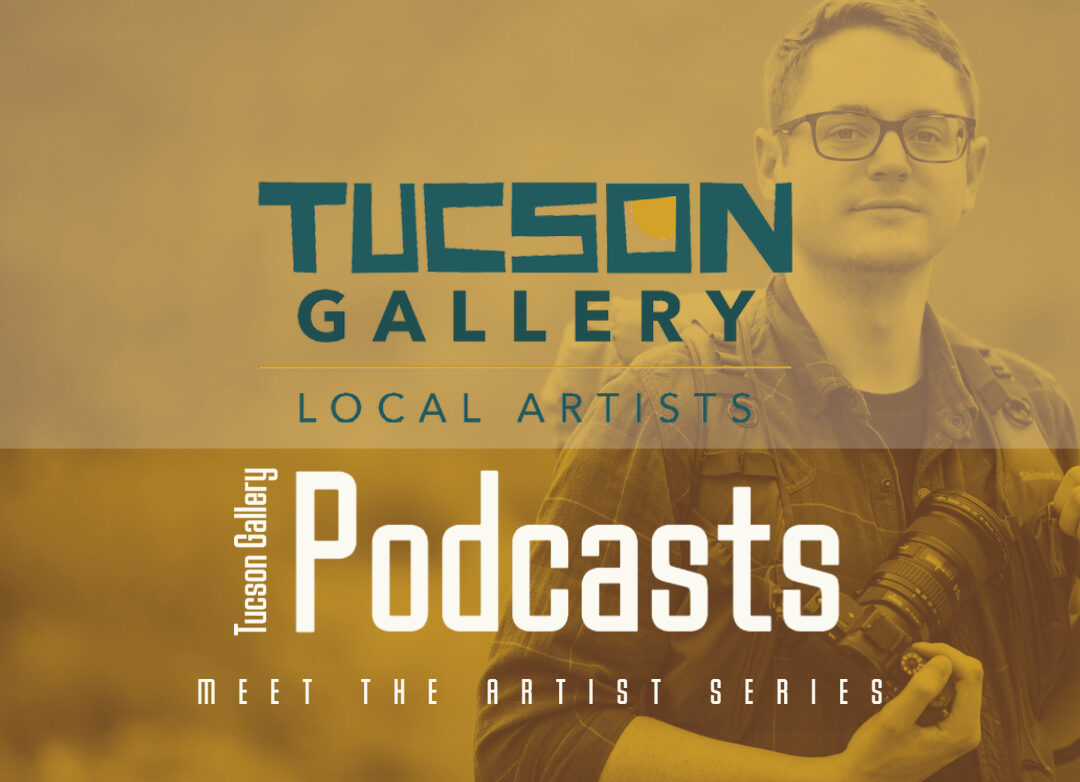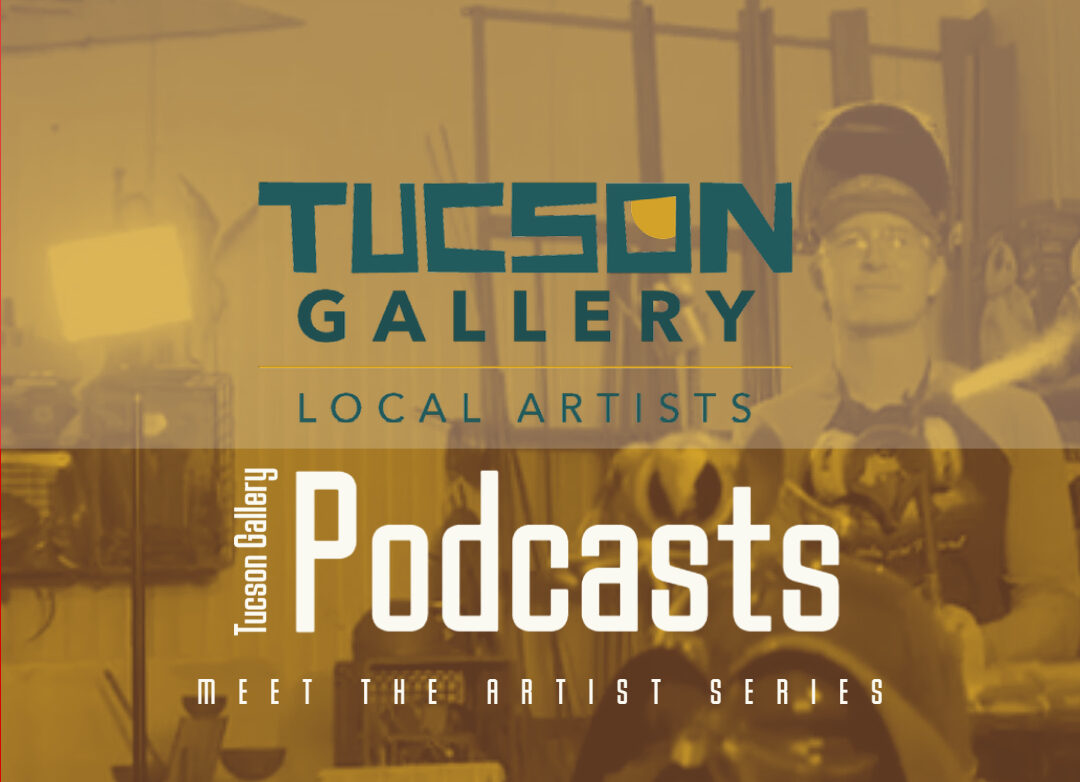Transcript (Unedited)
Tom Heath
And yet, once again, we are here at the Tucson Gallery inside of the proper shops in downtown Tucson for another fabulous installment of Meet the Artist. Each week, we have one of our fabulous Tucson artists come into the gallery, spend some time hanging out with a fan, signing autographs. And as part of that, we pull them away from the crowd and record these fabulous this Meettheartist podcast. All of the past episodes are on our website, thetucsongallery.com as well as the schedule of events. And probably most importantly on there, there’s a newsletter you can sign up for that get once a month updates on what’s happening inside the gallery and the proper shops, the artists, the music, the events. All kinds of crazy stuff happening here in downtown Tucson. And if you are looking for souvenirs from Tucson or gifts that represent Tucson, this is the place to come. And we’re talking to the man today who made those. We have the Jeff Brack joining us today.
Jeff Brack
Hello.
Tom Heath
All right. First time he’s ever been on a radio. Just kidding. We’ll talk about it, but he’s got a storied career in the film and sound industry. But in the gallery, we have merch for Mr. Jeff. Tell us a little about your merch.
Jeff Brack
Yes. So it’s Tucson branded t shirts and hats, simply put. But you want to kind of hear.
Tom Heath
The yeah, these aren’t just Tucson branded. Like, oh, hey, we got the word Tucson. You got, like, shadows and you got all kinds of cool art happening here. Did you design these?
Jeff Brack
Yeah, so I designed them and it came out of a couple of things. So one was, wherever I travel, I like to find cool shirts from New York or Moab, Utah, or Denver, Colorado, or wherever I’m at. Just something I like. It’s fun to do and a lot of tours like that. And I noticed I hadn’t seen a lot of that in Tucson. A lot of good t shirts, hats. And at the same time, I was also trying to think of a cool idea that I could do for friends and family. During the holidays, I was designing the T shirts over at Roadhouse Cinemas, which is my day job as a creative director there. And I thought, well, I already know the ins and outs of the T shirt design business. And so I started working on some Tucson designs. And so for the last maybe four or five years, I’ve done Tucson themed t shirts and hats for my friends and family for Christmas. It was Christmas gifts. I can put an order in. Also, I didn’t mention that my passion for Tucson is a way the reason why I wanted to do it was I love our city, I love
Jeff Brack
our culture, I love representing Tucson. And so that was part of it too. I could have made anything for these gifts, but I wanted to highlight Tucson.
Tom Heath
To my friends and family, not just your big face on a shirt that says Merry Christmas from Jeff.
Jeff Brack
From me.
Tom Heath
If you’re not sure it’s the guy.
Jeff Brack
In your shirt, I wanted to highlight something cool.
Tom Heath
So those designs that you created, are those the ones that we have in the gallery? Are there, like, Jeff Brack originals out there that we haven’t seen?
Jeff Brack
There’s some you haven’t seen.
Tom Heath
I see treasure hunt happening. I see some value coming in here from some of these hidden items out there. There’s only like, a limited edition of 2015 Jeff Brack Christmas shirts. So if you got those, you might want to hang on to them. They’re going to be keep them in the box. Don’t open that box. Keep them in mint condition.
Jeff Brack
There’s a few that the family and friends have that aren’t out here. Some of these are the ones that I gave as gifts. There is one of the designs with the backlit 3D Tucson the sororo that was designed specifically for this gallery.
Tom Heath
Oh, yeah. We love the exclusivity.
Tom Heath
If you haven’t seen them, you’ve got to come to the gallery. I don’t know if we have do we have them on the website yet, at least for an image?
Jeff Brack
Yeah, you can get them on the website.
Tom Heath
So we can’t buy them yet on the website. We’re still trying to figure out that shipping piece of it from a merchandise in the gallery. We can ship a lot of the reproductions because we work with a third party to do that, but the stuff in the gallery haven’t quite gotten there yet. But we will. But I like them. And you should check them out on the Tucsongallery.com website because they’re the sort of balance between elegance and simplicity. A lot of T shirts, you see, like a lot of these touristy T shirts. There’s too much going on and you sort of lose that city. And here you’ve got Tucson is very obvious there. But there’s also entertaining. You’ve got things going on with a suwaro in the a mountain in the background. And the way you’ve put where you’ve put the word Tucson, how you put it. I know it might sound silly, but I think there’s an elegance and a simplicity to your shirts that make them, to me, very eye catching and appealing.
Jeff Brack
Oh, thank you. Yeah, I really like the use of negative space. There’s a design where the letters are actually the T shirt color coming through. And so I like doing that a lot where you actually utilize the T shirt as another color.
Tom Heath
Yeah, I think my favorite part is that I saw one of your shirts. I’m like, that’d be an awesome hat. And then about a month later, you show up with hats.
Jeff Brack
The that may have been your idea.
Tom Heath
It was my idea. I made you do. I’m like, we’re not putting you in a gallery unless you get hats. Yeah, but they have the Tucson with the A Mount and the cactus in the background. And I think I might have bought the first one. I should have had you sign it. Now it’s a little worn, but I do get compliments on that hat. And people are like, where’d you get I’m like, Tucson Gallery. It’s the only place you can find these. It’s a Jeff Brack original.
Jeff Brack
Oh, that’s cool. I’m glad you get good feedback on it.
Tom Heath
We should mention that your wife Julie is also an artist. And I’m kind of teasing because her brand is Julie’s original, Julie originals. And so I’m trying to get this Jeff Brack Originals to go with that. Is your company set up and your company name?
Jeff Brack
No, just the Tucson Gallery. That’s my all right. That’s my company.
Tom Heath
You got to get the Jeff Brack original series going here. I’m telling you, these things are they’re popular. We sell quite a bit of these as it goes.
Jeff Brack
I’m going to keep adding to it. I have some other designs I might bring in that highlight some areas around Tucson. One is presidio. San Augustine del Tucson. The original name Tucson.
Tom Heath
Yeah.
Jeff Brack
It’s an image of the old fort that I found in a history book. And then I have another one for Sabino Canyon.
Tom Heath
And I know you’ve given us sort of the nice exclusivity of selling these, but you need to get these out to other places. Like when you do the Presidio T shirt, you go over there and talk to them because they have a gift shop that’d be fabulous in there.
Jeff Brack
Yeah. To the museum.
Tom Heath
Yeah. Over there. And I mean through Sabino Canyon. The Parks and Rec. I would think they would want to use those as a little bit of a money maker for those. Give us the 3D Soaro as our exclusive. That’s the only place you can get that and maybe the hats. But I think your stuff, it needs to get out to more people because not only is it’s a symbol of the art in Tucson as well, I.
Jeff Brack
Like that it’s a celebration in Tucson, but also our gallery council serve as a tourist. What’s the word we were using?
Tom Heath
A destination? A Mecca trap or a tourist trap? Is that the word you’re looking for?
Jeff Brack
I don’t think the word is escaping me, but it’s a place where people can come pick up some memorabilia.
Tom Heath
Okay. Yeah.
Jeff Brack
Well, we have a lot of tourists walking around downtown, and there’s not a lot of places selling Tucson gear, so I’m glad we have it right here. It’s a great location, and hopefully some people walk away.
Tom Heath
Yeah. And then I think the other thing to talk about is the quality of the shirt. Right. You don’t just slap these on some basic cotton T shirts you can pick up, do you? Spend some money and get a really quality shirt?
Jeff Brack
I know it sounds silly, but just a straight cotton standard shirt, that doesn’t do it for me. So there’s a brand called Next Level that a lot of printers will use, but it is an expensive shirt, but it’s a blend of cotton and synthetic. And so it’s very soft. It doesn’t shrink, it stays soft. And that’s important to me, too, mostly from a selfish standpoint, if I’m going.
Tom Heath
To wear it, which you do all the time. I’ve never seen you in anything but a Jeff Brack original.
Jeff Brack
That’s not true.
Tom Heath
It is true. I don’t think I have. I don’t think I’ve seen you in the six months that we’ve been open. Every time you come in, you’ve been wearing a Jeff Brack original.
Jeff Brack
Let me be intentional.
Tom Heath
Yeah, I think so. It’s good marketing, but I want to shift gears a little bit because this is a project and I know it’s sort of a side hustle off of a side hustle, but from an art standpoint, you are an accomplished filmmaker. And I know it’s not part of the gallery, but I do want to talk about that because you got an exciting project. And as of the recording of this podcast, there’s still some anxiety around it. But you’re up for some awards here and those Darn writers are on strike. So there’s a hold on this. But tell us a little about your film and your career and what you’re doing.
Jeff Brack
Well, accomplished is generous of you. No, definitely. I’ve made a lot of short films and a pilot for TV series in the past. And worked as a TV commercial producer.
Jeff Brack
Yeah, I have a background in it. I studied film in college, and that’s really my first love, is filmmaking. So I did write a new screenplay, a feature screenplay that I’ve been pushing out kind of aggressively into screenplay contests, mostly in La. And I’ve gotten tremendous feedback. I’ve had six finalist finishes. One of them is still in the mix for the top ten, the last ten screenplays. So it could get option from that.
Tom Heath
Get option mean, like someone could purchase it to make it into a movie.
Jeff Brack
To develop it into a project. Yeah, they pay you when they option. So the way that this contest works is that final? Actually, it’s easy to say top ten. It’s actually the last nine. So these nine scripts are all sent to this big production company and they read them and then they’re going to choose one to develop. And they will pay you for an option, which means it’s their option for a year or whatever, the period that’s decided. And then if they are able to get the actors and the funding and everything put together, which is the development of it, and they can package it, and they decide they’re going to go into production within that time period, then they pay you for a preset fee that was decided for the cost of the screenplay. So you can get paid twice. You get the small amount for the option. You can get the full amount for.
Tom Heath
The actual and then after the option period, if they choose not to make it, then you get the script back. You can go back to and you don’t have to pay them back the option fee or anything like that. And then if it gets picked up, do you have control or say in how it’s made or is that part of the deal? Like once you option it, they can do whatever they want with your stuff?
Jeff Brack
Likely that’s the case. So yeah, they could do what they want with it. They can even rewrite it. So it may not even end up resembling what you originally wrote. It may just be inspire the next draft. But sometimes you can negotiate to be a continuing writer on the project. You can write new revised scripts for them. I guess it depends on their interest in having to be involved or whether is the artist can negotiate more involvement. But I think the standard deal is they just take it.
Tom Heath
I would imagine like any other artist, when you’re starting out and getting your foot in the door, you’re just happy to meet someone that’s interested in the work that you’re doing. And then the second one you’re like, hey, wait a minute, I didn’t do so on that first one. And then by the third one you’re like, no, this is how it’s going to go. If you want my stuff, this is how it’s going to go. Otherwise I’m going to take it across the street.
Jeff Brack
Right? You need that first project produced so you have a credit produced credit. And my real love is directing and I write to direct. But if the right situation arises where they want to option it and take it, that’s something that has to be seriously considered because getting a project out there and getting it made, that can be, like you said, open doors.
Tom Heath
We’re going to direct people over to my other podcast, Life Along the Streetcar, because you and I did an interview just after they announced the state incentives for the film industry and that’s going to have a huge impact. So I don’t want to dig too deeply in that because it’s sort of off topic from the gallery. But again, if you head over to the other podcast, lifealongthreestreetcar.org, just put Jeff Brack’s name into the search bar there and it’ll pull up the interview that we did and talking about what a very bright future for the film industry here is in Tucson. It’s been a while since recorded that. Are you still hopeful that that’s going to happen?
Jeff Brack
It’s happened. So it has happened. Small update on some of the things we talked about that ended up not being correct because it was early days, we didn’t know exactly how it was going to be hashed out.
Tom Heath
We were doing breaking news, we were breaking the news right then and there. And sometimes when you’re in that fury. You don’t always get all the facts right, but you do your best well.
Jeff Brack
And you can try to get the facts right, but then they change them because the negotiations continue. And the rules but the program is live. They’ve finalized the rules. The Arizona Commerce Authority, I think, is what actually runs it. But the application, I think it’s gone live and it can be retroactive. Productions can apply now for things going all the way back to January. Okay, so there are productions already coming in, but we are going to see an increase in film and television production, and that’s exciting. Even for small productions, there’s no limit to the budget. So if we decide to try to produce my script locally on our own, we still qualify for assistance.
Tom Heath
Listen out there, Funders. If you’re looking to get involved with the project, you got a script and a director sitting right here, and he’s going to make his own merch. It’s perfect. It’s perfect.
Jeff Brack
And I have a website, Jeffreyscottbrack.com, that has all the updates and news on the project and the status and feedback from screenplay contests and producers.
Tom Heath
Is the screenplay on there or at least like a synopsis of it or.
Jeff Brack
Like a log line is on there?
Tom Heath
I don’t know what a log line is.
Jeff Brack
One sentence description people can request on the website, the pitch deck and the script.
Tom Heath
Okay. Do you want to vet them first so they just don’t take your stuff and run? Is that pretty much how this industry works?
Jeff Brack
Yeah. You got to be a little cautious. Okay.
Tom Heath
But if you’re seriously thinking about funding or taking advantage of these new film credits and want to support local, I’m sure you’ve got a crew of people that you can put together to help get this thing launched, too.
Jeff Brack
Yeah, absolutely.
Tom Heath
Can you tell us at least the title of this movie?
Jeff Brack
Title is the Last Road Trip. Yeah, I can give you the basic gist of it. Two best friends are reluctantly hired to drive a dead body from Austin, Texas to Tucson, Arizona for a funeral.
Tom Heath
I love it. I love it. Come on, Funders, let’s get out there. I’ll bring the popcorn. Anyway, Jeff, it’s good to have you in the gallery. Your merchandise hats and T shirts are selling. I’m looking forward to maybe a couple more designs as they roll out, when you have time and not making films and heading to Hollywood and doing your day job, but still paying the bills for a while. And then do you put this stuff out, like on social media? Do you have Instagram, Facebook people can follow you? Or is it just Jeffreyscotbrack.com?
Jeff Brack
You mean for the merch?
Tom Heath
For the merch or just about you and your film and stuff?
Jeff Brack
Just you, yeah, the the Jeffreescotbrack.com is my film site.
Tom Heath
Any social media people can and actually.
Jeff Brack
There is a portfolio on there that does have some of the designs, some graphic design work. But these are actually you can see them on the gallery website. You can see them on my wife’s website. Juliangels.com. Okay.
Tom Heath
I’m trying to get to do you personally if people want to follow you to see what’s up. Do you have social media?
Jeff Brack
Oh, absolutely, yes.
Tom Heath
How do people link to you on that?
Jeff Brack
Yeah. So just Jeff Brack on Facebook and Jeff S brack on Instagram.
Tom Heath
Can’t get more simple than that. Thank Kevin. It’s brack. Are there a lot of bracks out there?
Jeff Brack
No, it’s pretty rare name.
Tom Heath
There you go. There you go. Rare name, rare shirts, rare hats, rare movies. We got it all here at the Tucson Gallery and you can learn about Jeff and all the other fabulous artists. I think we’re up to like 25 represented in the gallery. We just did a meeting with the artist and it was like this like this celebrity red carpet event. All these fabulous artists showed up and a lot of them hadn’t met each other. It’s a lot of fun. But you can check out all of our artists on the Tucsongallery.com. You can listen to past episodes, sign up for the newsletter so you can find out when your favorite artist is going to be live. And if you’ve missed that window and they’ve already been in, don’t worry, they’ll probably come back. But in the meantime, they’ll have a podcast up and you can listen to it. And it’s all happening inside of here. The proper shops, 300 East Congress. We’re in downtown Tucson. We’re right on the corner of Fifth in Congress. You can’t miss us. We’re kind of sandwiched in between
Tom Heath
hotel congress, rialto theater and the playground. We’re in a really popular corner. So come on down, check us out and meet people like Jeff. They’re keeping Tucson very beautiful and creative. So thank you again for your time.
Jeff Brack
Thank you, Tom. This is fun.
Tom Heath
Thank you for listening to Meet the Artist. This is a weekly production by the Tucson Gallery located inside of the proper shops at 300 East Conga Street in Tucson, Arizona. The mission of the Tucson Gallery is to support local artists by providing a space to show their art, a forum to engage with their audience, a virtual presence to connect with global patrons, an outlet to earn a fair price, and an opportunity to hone their business skills. Head over to thetussonggallery.com for more information about our live events. Listen to other Meet the Artist podcasts and check out the wide selection of art gifts and other items created by Tucson’s modern, thought provoking and forward thinking artists.
